German Artists who Resisted Adolf Hitler
During the First World War several artists, including Helmut Herzfeld, Otto Dix and George Grosz, campaigned against the conflict. These men hated the strong nationalism that had emerged during the war in Germany. Helmut Herzfeld, shared this view and decided to change his name to John Heartfield in 1916 in "protest against German nationalistic fervour". Grosz decided to follow his example changed the spelling of his name to "de-Germanise" and internationalise his name – thus Georg became "George".
Käthe Kollwitz, an active member of the Social Democratic Party (SDP) was a mother during the First World War. On 23rd October, 1914, her son, Peter Kollwitz was killed at Dixmuide in Belgium on the Western Front. She later admitted that she had not argued against her sons joining the German Army "because there was the conviction that Germany was in the right and had the duty to defend herself." However, over the next few years she became an anti-war artist.
After the war Heartfield and Grosz joined the German Communist Party (KPD) and supported the German Revolution. It failed but Heartfield and Grosz refused to be beaten and joined forces with other left-wing artists, novelists, poets, playwrights, musicians, film and theatre directors, to resist nationalism and fascism. This included Bertolt Brecht, Erwin Piscator, Ernst Toller, Hannah Arendt, Günther Stern, Erich Mühsam, Kurt Weill, Hanns Eisler, Heinrich Mann, Erika Mann, and Heinrich Blücher.
This resistance was unsuccessful and most of them were either murdered on the orders of Adolf Hitler or managed to escape to the Soviet Union, the United States or Britain. Kollwitz did remain in Germany and although her art works were confiscated, because of her age, she was not sent to a concentration camp. Dix also remained in Germany but was not allowed to teach or display his art.
John Heartfield
Helmut Herzfeld was born in Berlin, Germany on 19th June, 1891. His father, Franz Held, was a socialist writer and his mother, Alice Stolzenberg, was a textile worker and a trade union activist. As a result of their politics the family was forced to flee to Switzerland in 1896. (1)
After leaving school at fourteen Herzfeld worked for a bookseller, Heinrich Heuss, in Wiesbaden. In 1907 he became an assistant to the painter, Hermann Bouffier, and two years later became a student at the School of Applied Arts in Munich. In 1912 Herzfeld started work as a designer in Mannheim for a year before moving to Berlin to study under Ernst Neumann at the Arts and Crafts School. (2)
Helmut Herzfeld was drafted into the German Army in 1915 but succeeds in evading military service. (3) Karl Liebknecht, the leader of the Spartacus League, a secret organization, published a pamphlet, The Main Enemy Is At Home! He argued: "The main enemy of the German people is in Germany: German imperialism, the German war party, German secret diplomacy. This enemy at home must be fought by the German people in a political struggle, cooperating with the proletariat of other countries whose struggle is against their own imperialists. We think as one with the German people – we have nothing in common with the German Tirpitzes and Falkenhayns, with the German government of political oppression and social enslavement. Nothing for them, everything for the German people. Everything for the international proletariat, for the sake of the German proletariat and downtrodden humanity." (4)
On 1st May, 1916, the Spartacus League decided to come out into the open and organized a demonstration against the First World War in Berlin. Helmut Herzfeld was in the crowd that day and heard Liebknecht and Rosa Luxemburg call for everyone to resist Germany's involvement in the war. Several of its leaders, including Liebknecht and Luxemburg were arrested and imprisoned. Wieland Herzfelde, said that the speeches at the rally had a great influence on his brother. It was at this point he decided to dedicate his art to politics. Wieland later wrote: "We are the soldiers of peace. No nation and no race is our enemy." (5) A pacifist and Marxist, Herzfeld, changed his name to John Heartfield in 1916 in "protest against German nationalistic fervour". (6)
Heartfield began contributing work to Die Neue Jugend, an arts journal published by his brother. His friend, George Grosz, who worked with him at the journal, later recalled how John Heartfield "developed a new very amusing style of using collage and bold typography". (7) Grosz helped him develop what became known as photomontage (the production of pictures by rearranging selected details of photographs to form a new and convincing unity). We... invented photomontage in my South End studio at five o'clock on a May morning in 1916, neither of us had any inkling of its great possibilities, nor of the thorny yet successful road it was to take. As so often happens in life, we had stumbled across a vein of gold without knowing it." (8)
In 1918 Heartfield and Grosz joined the newly formed German Communist Party (KPD) and over the next fifteen years produced designs and posters for the organization. (9) He participated in the First International Dada Fair of 1920. It is claimed that Heartfield had a major influence on the German Dada group that included Otto Dix, Max Ernst, Raoul Hausmann and Kurt Schwitters. (10)
Sergei Tretyakov was another artist linked to the Dada group. "Heartfield's first Dadaist photomontages are still marked by their abstract nature. Scraps of photograph and printed text are arranged not so much according to meaning but according to the aesthetic mood of the artist. The Dadaist period in Heartfield's work did not continue for long. He soon ceased to waste his artistic talents in abstract fireworks. His works became aimed shots... Soon no line could be drawn between his montages and his party work." (11)
Over the next few years Heartfield produced posters for the KPD. However, to earn a living he worked briefly as a set designer for Max Reinhardt and more consistently for the revolutionary theatre of Erwin Piscator. He also designed book jackets for the left-wing publishers, Malik Verlag. In 1923 Heartfield became editor of the satirical magazine, Der Knöppel. (12)
Bertolt Brecht first met Heartfield in 1924. He pointed out that John Heartfield soon became one of the most important European artists. "He works in a field that he created himself, the field of photomontage. Through this new form of art he exercises social criticism. Steadfastly on the side of the working class, he unmasked the forces of the Weimar Republic driving toward war." (13) Heartfield wrote: "Art and agitation are mutually exclusive". (14)
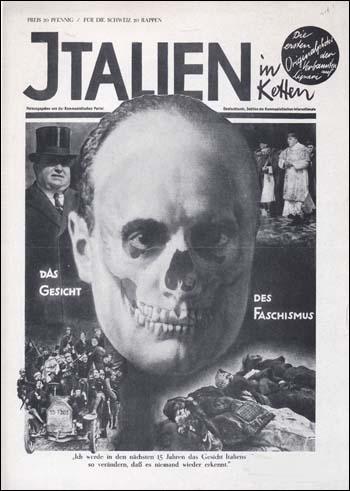
(Copyright The Official John Heartfield Exhibition & Archive)
Wieland Herzfelde argued "he consciously placed photography in the service of political agitation". (15) In 1928 he created The Face of Fascism, a montage that dealt with the rule of Benito Mussolini which spread all over Europe with tremendous force. "A skull-like face of Mussolini is eloquently surrounded by his corrupt backers and his dead victims". (16)
Heiri Strub has pointed out that Heartfield made the decision to use his art for political causes. "Heartfield always considered his photomontages as artistic achievements. He took in stride the fact that he was not recognized by contemporary art critics. The works he created for dissemination in huge editions had no value in the art market. Directing his political charges at the masses, he could scarcely count on a sympathetic reaction from bourgeois art collectors. The worker, however, for whom he intended his photomontages, understood their revolutionary content, but assigned no artistic value judgment to them." (17)
John Heartfield began working for the socialist magazine, Arbeiter-Illustrierte-Zeitung (AIG) in 1929. During this period it became the most widely socialist pictorial newspaper in Germany. Circulation reached 350,000 in 1930. (18) Zbyněk Zeman has pointed out that at this stage Heartfield concentrated his attack on "Prussian militarism and the large-scale industries and industrialists who supplied it with arms". (19)
The German novelist, Heinrich Mann, was one of those who saw the significance of the magazine: "The Arbeiter-Illustrierte-Zeitung is one of the best of current picture newspapers. It is full in its coverage, technically good, and, above all, unusual and new... Aspects of daily life are seen here through the eyes of the worker, and it is time that this happened. The pictures express complaints and threats reflecting the attitude of the proletariat - but at the same time this proves their self-confidence and their energetic activity to help themselves. The self-confidence of the proletariat in this weary part of the world is most heartening." (20)
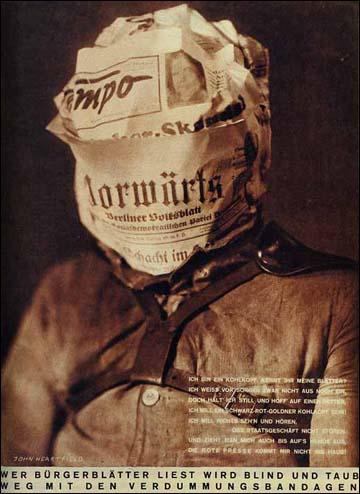
become blind and deaf, Arbeiter-Illustrierte-Zeitung (AIG) (February 1930)
(Copyright The Official John Heartfield Exhibition & Archive)
Heiri Strub worked with Heartfield at the magazine. "Heartfield's high demands of quality made collaboration with him difficult. His long-time colleague, the photographer Janos Reismann, related how Heartfield constantly demanded new pictures until he saw his idea realized... With photographic tricks and painting Heartfield arranged the parts of the photo to fit together seamlessly. With extraordinary care he devised his adhesive picture, so that after final retouching it went straight to the printer. Since the AIZ was produced using the highly sensitive copperplate photogravure method, errors were as evident as the artist's real intention. Heartfield's respect for the skills of others was so great that he himself did not do the photography, and he left the retouching to others, but always under his stringent supervision." (21)
Louis Aragon has argued: "John Heartfield is one of those who expressed the strongest doubts about painting, especially its technical aspects... As we know, Cubism was a reaction of painters to the invention of photography. The photograph and the cinema made it seem childish to them to strive for verisimilitude. By means of these new technical accomplishments they created a conception of art which led some to attack naturalism and others to a new definition of reality. With Leger it led to decorative art, with Mondrian to abstraction, with Picabia to the organization of mundane evening entertainment. But toward the end of the war, several men in Germany (Grosz, Heartfield, Ernst) were led through the critique of painting to a spirit which was quite different from the Cubists, who pasted a piece of newspaper on a matchbox in the middle of the picture to give them a foothold in reality. For them the photograph stood as a challenge to painting and was released from its imitative function and used for their own poetic purpose." (22)
John Heartfield's main target in the early 1930s was Adolf Hitler and his Nazi Party. His work often appeared on the front cover of AIG. In 1930 the magazine published twelve of his photomontages. This included one that showed Fritz Thyssen, the owner of United Steelworks, a company that controlled more that 75 per cent of Germany's ore reserves and employed 200,000 people. In the photomontage, Thyssen is shown working Hitler as a puppet.
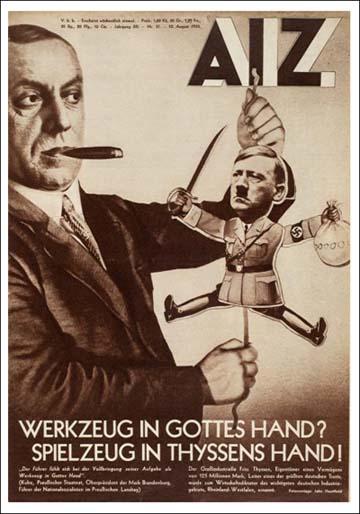
(Copyright The Official John Heartfield Exhibition & Archive)
In 1932 Heartfield produced 18 photomontages for AIG. The most famous of these appeared just before the November 1932 General Election. Hitler is showed standing in front of a large man who represents big business. The man is handing over money to Hitler. Printed underneath are the words: "Motto: Millions stand behind me! A little man asks for gifts". Heartfield's friend, Oskar Maria Graf, commented, that all his work was now politically motivated, "the intolerable aspect of events is the motor of his art". (23)
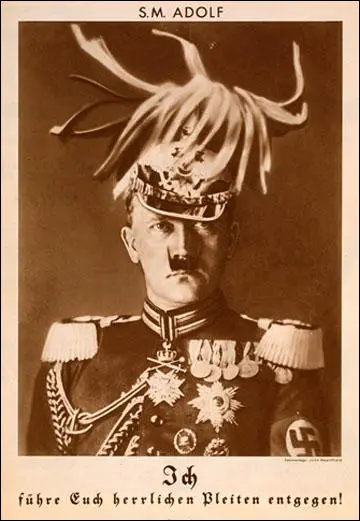
(Copyright The Official John Heartfield Exhibition & Archive)
Richard Carline was an English artist who met him during this period: "Slight and little more than five feet tall, Heartfield displayed the unmistakable traits of genius - single-minded and purposeful. With his intense, unpretentious, and uninhibited personality, he warmed toward everyone he met without regard for class or background. He would talk to animals as if they were humans." (24)
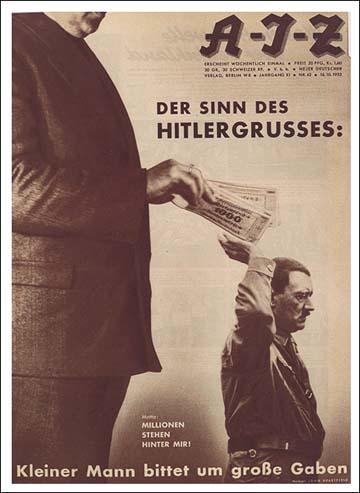
(Copyright The Official John Heartfield Exhibition & Archive)
In the election in November 1932 the Nazi Party won 230 seats, making it the largest party in the Reichstag. The German National Party, won nearly a million additional votes. However the German Social Democrat Party (133) and the German Communist Party (89) still had the support of the urban working class and Hitler was deprived of an overall majority in parliament. In numerical terms, the socialist parties obtained 13,228,000 votes compared to the 14,696,000 votes recorded for the Nazis and the German Nationalists. (25)
Soon after Hitler became chancellor in January 1933 he announced new elections. Hermann Goering called a meeting of important industrialists where he told them that the election would be the last in Germany for a very long time. He explained that Hitler "disapproved of trade unions and workers' interference in the freedom of owners and managers to run their concerns." (26) Goering added that the NSDAP would need a considerable amount of of money to ensure victory. Those present responded by donating 3 million Reichmarks. As Joseph Goebbels wrote in his diary after the meeting: "Radio and press are at our disposal. Even money is not lacking this time." (27)
On 27th February, 1933, the Reichstag caught fire. When they police arrived they found Marinus van der Lubbe on the premises. After being tortured by the Gestapo he confessed to starting the Reichstag Fire. However he denied that he was part of a Communist conspiracy. Hermann Goering refused to believe him and he ordered the arrest of several leaders of the German Communist Party (KPD).
When Hitler heard the news about the fire he gave orders that all leaders of the German Communist Party should "be hanged that very night." Paul von Hindenburg vetoed this decision but did agree that Hitler should take "dictatorial powers". KPD candidates in the election were arrested and Hermann Goering announced that the Nazi Party planned "to exterminate" German communists. John Heartfield responded to these events by producing Goering the Executioner of the Third Reich. It shows the "human bloodhound with his axe standing in front of the burning parliament." (28)
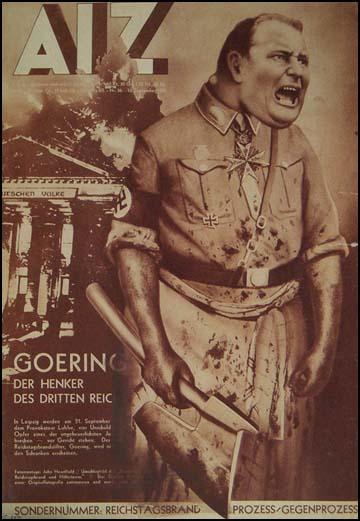
(Copyright The Official John Heartfield Exhibition & Archive)
Behind the scenes Goering, who was minister of the interior in Hitler's government, was busily sacking senior police officers and replacing them with Nazi supporters. These men were later to become known as the Gestapo. Goering also recruited 50,000 members of the Sturm Abteilung (SA) to work as police auxiliaries. Goering then raided the headquarters of the German Communist Party (KPD) in Berlin and claimed that he had uncovered a plot to overthrow the government. Leaders of the KPD were arrested but no evidence was ever produced to support Goering's accusations. He also announced he had discovered a communist plot to poison German milk supplies. (29)
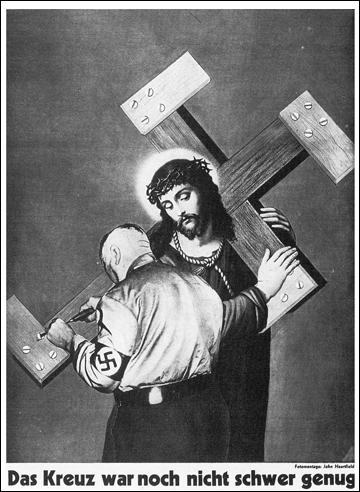
(Copyright The Official John Heartfield Exhibition & Archive)
Thousands of members of the Social Democrat Party and trade union activists were arrested and sent to recently opened concentration camps. Left-wing election meetings were broken up by the Sturm Abteilung (SA) and several candidates were murdered. Newspapers that supported these political parties were closed down during the election. Although it was extremely difficult for the opposition parties to campaign properly, Hitler and the Nazi party still failed to win an overall victory in the election on 5th March, 1933. The Nazi Party received 43.9% of the vote and only 288 seats out of the available 647. The increase in the Nazi vote had mainly come from the Catholic rural areas who feared the possibility of an atheistic Communist government.
Adolf Hitler ordered the arrests of all those artists that had criticized him during his rise to power. (30) On 16th April, 1933, members of the Sturmabteilung (SA) arrived at Heartfield's apartment. Heartfield had been warned about what was going to happen and he managed to flee to Prague. This now became the place where AIG was published. That year Heartfield produced 35 front-covers. However, it was very difficult to smuggle the magazine back to Germany and circulation dropped dramatically from the 500,000 copies that were being sold before Hitler took power. (31)
All forms of mass communication were now controlled in Nazi Germany. The man in overall charge was Dr. Joseph Goebbels, the Minister of Propaganda. Lists were drawn up of books the Nazis believed contained "un-German" ideas and then all available copies were publically destroyed. The Nazis were especially hostile to works produced by left-wing writers like Bertolt Brecht and Ernst Toller.
Heartfield was especially upset by the passing of the Enabling Bill. This banned the German Communist Party and the Social Democratic Party from taking part in future election campaigns. This was followed by Nazi officials being put in charge of all local government in the provinces (7th April), trades unions being abolished, their funds taken and their leaders put in prison (2nd May), and a law passed making the Nazi Party the only legal political party in Germany (14th July). This situation motivated Heartfield to produce the Executioner and Justice on 30th November 1933.
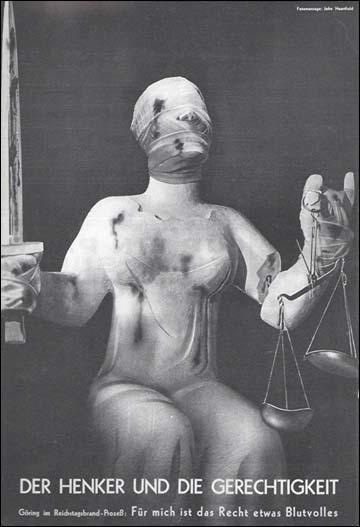
(Copyright The Official John Heartfield Exhibition & Archive)
Adolf Hitler became increasingly annoyed with John Heartfield's photomontages published in Prague (35 in 1933) and he told the government in Czechoslovakia to ban his work. In May 1934 the authorities agreed to Hitler's demands. This created a great deal of controversy and the French artist, Paul Signac, urged international action. He wrote a letter to Heartfield's supporters in Prague: "My whole life long I have been fighting for the freedom of art... I am prepared to contribute my share in organizing a French exhibition of our friend's works... The club is poised for battle against the freedom of the spirit. Let us unite to defend ourselves." (32)
The French poet, Louis Aragon, argued in Commune Magazine: "John Heartfield today knows how to salute beauty. He knows how to create those images which are the beauty of our rage since they represent the cry of the people - the representation of the people's struggle against the brown hangman with his craw crammed with gold pieces. He knows how to create these realistic images of our life and struggle arresting and gripping for millions of people who themselves are a part of that life and struggle. His art is art in Lenin's sense for it is a weapon in the revolutionary struggle of the proletariat." (33)
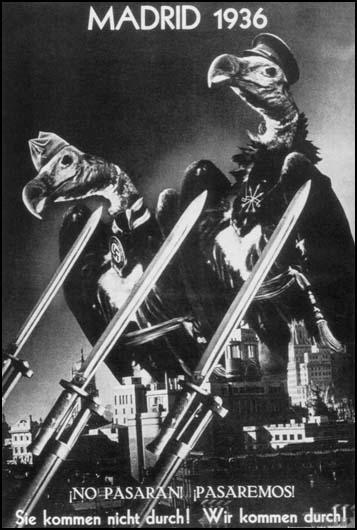
(Copyright The Official John Heartfield Exhibition & Archive)
Heartfield's friends in Europe helped to get his work published. Several photomontages on the Spanish Civil War were published. This included Madrid 1936, a work of art that dealt with the Siege of Madrid. Another poster, The Mothers to their Sons in Franco's Service, was published in December 1936. On the poster it said: "For what you were hired. Whom you are hounding. So permit us mothers to tell you: We grieve for you, young ones. No, we did not raise you to murder. You are allowing yourselves to be abused. You have been betrayed!" (34)
In October 1937 John Heartfield published Warning. In the photomontage an audience looks at a scene of horror caused by Japanese air raids in Manchuria. "Heartfield's pastiche layers in several rows of faceless male heads, backs towards us, beneath the frontal stare of an on-screen victim in the violent newsreel footage at which they are staring: a Chinese mother holding a bloodied child in outsized close-up." It had the caption: "Today you see a film of war in other countries. But remember, if you don't unite to resist it now, tomorrow it will kill you, too!" It was a prediction that was to come true within two years. (35)
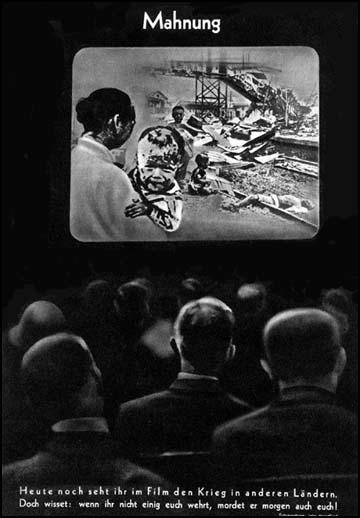
(Copyright The Official John Heartfield Exhibition & Archive)
When Adolf Hitler ordered the invasion of Czechoslovakia after the Munich Agreement of 1938 John Heartfield was forced to flee the country. In December he arrived in London. Over the next few months his work appeared in the Reynolds News and Lilliput. He spoke at political rallies, organized anti-Fascist groups, and took part in a successful political cabaret, Four and Twenty Black Sheep. On 23rd September, 1939, Picture Post used one of Heartfield's earlier photomontages, His Majesty Adolf, which showed Hitler wearing the Kaiser's uniform and moustache, on its front-cover. (36)
On the outbreak of the Second World War he was interned with fellow refugees who had suffered under the Nazis and were now dubbed "enemy aliens". He was suffering from poor health and he was eventually released but he was not asked to work for the British government. "His whole ambition was to make people fully aware of the menace of Fascism and to expose the Nazi tyranny through his work as an artist... The powerful contribution he might have made toward the Allied victory through his mastery of satire was not acceptable to the British authorities. They were highly suspicious of art, especially experimental forms of art by a German refugee." (37)
One of John Heartfield most powerful photomontages, This is the Salvation that they Bring!, that had originally been published in protest against the Spanish Civil War, was republished during the Blitz. On the poster it had an extract from an article that appeared in the Nazi Party funded Berlin Journal for Biology and Race Research: "The densely populated sections of cities suffer most acutely in air raids. Since these areas are inhabited for the most part by the ragged proletariat, society will thus be rid of these elements. One-ton bombs not only cause death but also very frequently produce madness. People with weak nerves cannot stand such shocks. That makes it possible for us to find out who the neurotics are. Then the only thing that remains is to sterilize such people. Thereby the purity of the race is guaranteed." (38)
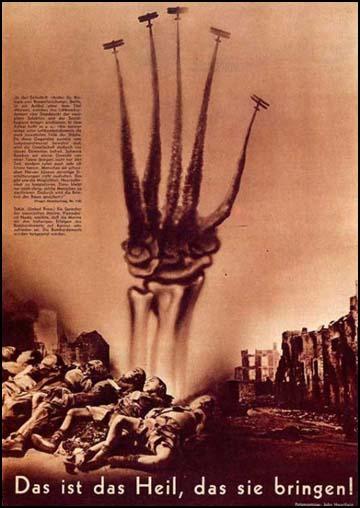
(Copyright The Official John Heartfield Exhibition & Archive)
John and his third wife, Gertrud (Tutti) Heartfield, settled in Hampstead. During the war he was an active member of the Artists International Association and contributed to its exhibitions. Heartfield also designed book jackets for the London publisher Lindsay Drummond and Penguin Books. (39)
John Heartfield and his wife moved to Leipzig in East Germany in August 1950. Together with his brother, Wieland Herzfelde, he worked for publishers and organizations in the GDR. He also designed scenery and posters for the Berliner Ensemble and the Deutsches Theatre. However, as Peter Selz has pointed out, he found it difficult to produce political photomontages. "While he was celebrated as a cultural leader, his chief idiom, photomontage, was still suspect during the 1950s among the more orthodox advocates of socialist realism." (40)
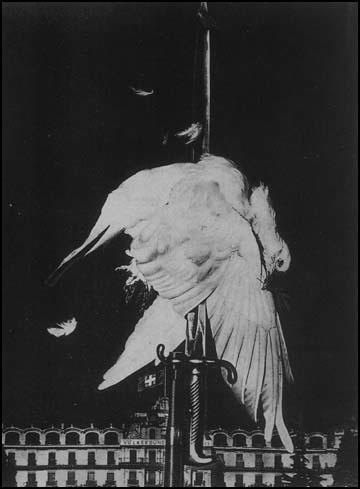
(Copyright The Official John Heartfield Exhibition & Archive)
Heartfield continued to be a peace activist and on 9th June 1967, at the time of an exhibition of his works at the Stockholm Modern Museum, he wrote about the dangers posed by the Vietnam War. "Since we are living in the nuclear age, a third world war would mean a catastrophe for all mankind, a catastrophe the full extent of which cannot be possibly be imagined.... The war of extermination against the Vietnamese people, fighting heroically for their existence... Now there is a war in the Middle East! Shortly before that, a monarchist-fascist putsch smothered every democratic political movement in Greece. The flames are licking at your doorstep! Today peace-loving men of all nations must work together even more closely; must mobilize all the resources to strengthen and preserve world peace, since powerful rulers again lust for war." (41)
The later years of life were devoted to designing brilliant costumes, stage sets, and stage projection for the East German Theatre. John Heartfield died in Berlin on 26th April, 1968. (42)
George Grosz
Georg Ehrenfried Grosz, the son of a pub owner, was born in Berlin, Germany, on 26th July, 1893. He was brought up by devout Lutheran parents. His father was warden at the local masonic hall. "My father himself used sometimes to draw on the large cardboard sheets pinned to the square table... I can still remember sitting on his lap and watching all sorts of creatures come to life under his hand." (43)
His father died in 1901 and the family moved to Berlin. "My mother and aunt sewed blouses for some big concern - hard work that brought in little cash. True, living was cheap, and we had enough of the bare necessities, but we were constantly beset by money worries now.... We were living in a real working-class district, though I did not realize it at the time." (44)
Grosz was a talented artist and began attending a weekly drawing class taught by a local painter. In 1909 he became a student at the Dresden Academy of Fine Arts, where his teachers were Robert Sterl and Osmar Schindler. In 1911 he moved to the Berlin College of Arts and Crafts where he studied under Emil Orlik. (45) During this period Grosz had his first caricatures published in the Berliner Tageblatt. (46)
On the outbreak of the First World War Grosz was conscripted into the German Army. "What can I say about the First World War, a war in which I served as an infantryman, a war I hated at the start and to which I never warmed as it proceeded? I had grown up in a humanist atmosphere, and war to me was never anything but horror, mutilation and senseless destruction, and I knew that many great and wise people felt the same way about it. At the outbreak of hostilities, Germany was in the throes of a kind of mass delirium, but when the first flush of that was over there was nothing to take its place." (47)
A strong opponent of the war, he was eventually released as unfit for duty. Grosz wrote to a friend "The time I spent in the stranglehold of militarism was a period of constant resistance - and I know there was not one thing I did which did not utterly disgust me... I have one dream: perhaps there will, after all, be changes, rebellions, perhaps one day international socialism which has lost its backbone will gather strength enough for an open uprising... It is an absurd dream, no more... to the slaughterhouse!" (48)
However, the following year, desperate for soldiers, Grosz was called up again. Kept from frontline action, Grosz was used to transport and guard prisoners of war. "In 1916 I was discharged from military service, or rather, given a sort of leave of absence on the understanding that I might be recalled within a few months. And so I was a free man, at least for a while. The collapse of Germany was only a matter of time. All the fine phrases were now no more than stale, rank printer's in on brown substitute paper. I watched it all from my studio in Sudende, living and drawing in a world of my own. I drew soldiers without noses; war cripples with crab-like limbs of steel; two medical orderlies tying a violent infantryman up in a horse blanket; a one-armed soldier using his good hand to salute a heavily bemedalled lady who had just passed him a biscuit; a colonel, his fly wide open, embracing a nurse; a hospital orderly emptying a bucket full of pieces of human flesh down a pit." (49)
Grosz hated the strong nationalism that had emerged during the war in Germany. Grosz's close friend, the artist, Helmut Herzfeld, shared this view and decided to change his name to John Heartfield in 1916 in "protest against German nationalistic fervour". (50) Grosz decided to follow his example changed the spelling of his name to "de-Germanise" and internationalise his name – thus Georg became "George". (51)
In the middle of 1917 Grosz was recalled to the German Army. "My new duties were to train recruits and to transport and guard prisoners of war. But I had enough and one night they found me semi-conscious, head-first in the latrine. I spent some time in hospitals after that. Whenever I had a moment to spare I would vent my spleen in sketches of everything about me that I hated, either in my notebook or on sheets of writing paper; the brutal faces of my comrades, badly mutilated war cripples, arrogant officers, lascivious nurses." (52)
Grosz had joined the Spartacus League, an anti-war organization, led by Karl Liebknecht and Rosa Luxemburg. He now considered himself a Marxist and a pacifist. He was terribly unhappy in the army and in 1917 he tried to commit suicide and Grosz was placed in an army hospital. According to Grosz, it was decided to execute him but he was saved by the intervention of one of his wealthy patrons, Count Harry Clemens Ulrich Kessler. Grosz was now diagnosed as suffering from shell-shock and was discharged from the German Army. (53)
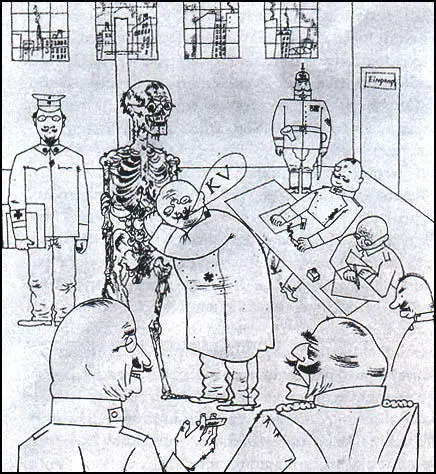
The war had a major impact on his art. George Grosz joined with John Heartfield in protesting about the German wartime propaganda campaign against the allies. He was also totally opposed to the war continuing when it was clear that victory was impossible. His most powerful anti-war drawings during this period, was such Fit for Active Service (1918), in which a well-fed doctor inspecting a skeleton with an ear trumpet and pronouncing a skeleton, "KV" fit for duty. Unconcerned with the diagnosis, the surrounding officers appear either bored or absorbed in other matters. (54)
The German government of Max von Baden asked President Woodrow Wilson for a cease-fire on 4th October, 1918. "It was made clear by both the Germans and Austrians that this was not a surrender, not even an offer of armistice terms, but an attempt to end the war without any preconditions that might be harmful to Germany or Austria." This was rejected and the fighting continued. On 6th October, it was announced that Karl Liebknecht, who was still in prison, demanded an end to the monarchy and the setting up of Soviets in Germany. (55)
By the 8th November, workers councils took power in virtually every major town and city in Germany. This included Bremen, Cologne, Munich, Rostock, Leipzig, Dresden, Frankfurt, Stuttgart and Nuremberg. Theodor Wolff, writing in the Berliner Tageblatt: "News is coming in from all over the country of the progress of the revolution. All the people who made such a show of their loyalty to the Kaiser are lying low. Not one is moving a finger in defence of the monarchy. Everywhere soldiers are quitting the barracks." (56)
On 7th November, 1918, Kurt Eisner, a member of the Independent Social Democratic Party (USPD) established a Socialist Republic in Bavaria. Several leading socialists arrived in the city to support the new regime. This included Erich Mühsam, Ernst Toller, Otto Neurath, Silvio Gesell and Ret Marut. Eisner also wrote to Gustav Landauer inviting him to Munich: "What I want from you is to advance the transformation of souls as a speaker." Landauer became a member of several councils established to both implement and protect the revolution. (57)
Konrad Heiden wrote: "On November 6, 1918, he (Kurt Eisner) was virtually unknown, with no more than a few hundred supporters, more a literary than a political figure. He was a small man with a wild grey beard, a pince-nez, and an immense black hat. On November 7 he marched through the city of Munich with his few hundred men, occupied parliament and proclaimed the republic. As though by enchantment, the King, the princes, the generals, and Ministers scattered to all the winds." (58)
George Grosz was a supporter of the German Revolution. Grosz was especially hostile to Friedrich Ebert, the leader of the German Social Democrat Party, and the leader of the government. "President Ebert had his beard trimmed, looked more and more like a managing director and changed his democratic felt hat for a shiny topper. Secretary of State Otto Meissner, the republic's master of ceremonies, made sure that he performed the office of his illustrious predecessors with due dignity and did not commit too many proletarian solecisms in the pursuit of his exalted duties." (59)
The Spartacus League published a leaflet that claimed: "The Ebert-Scheidemann government intends, not only to get rid of the last representative of the revolutionary Berlin workers, but to establish a regime of coercion against the revolutionary workers." It is estimated that over 100,000 workers demonstrated against the sacking of Eichhorn the following Sunday in "order to show that the spirit of November is not yet beaten." (60)
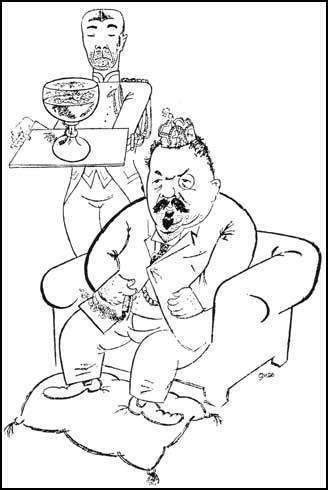
By 13th January, 1919 the rebellion had been crushed and most of its leaders were arrested. This included Rosa Luxemburg and Karl Liebknecht, who refused to flee the city, and were captured on 16th January and taken to the Freikorps headquarters. "After questioning, Liebknecht was taken from the building, knocked half conscious with a rifle butt and then driven to the Tiergarten where he was killed. Rosa was taken out shortly afterwards, her skull smashed in and then she too was driven off, shot through the head and thrown into the canal." (61)
Friedrich Ebert, the president of Germany, arranged for 30,000 Freikorps, under the command of General Burghard von Oven, to take Munich. At Starnberg, some 30 km south-west of the city, they murdered 20 unarmed medical orderlies. The Red Army knew that the choice was armed resistance or being executed. The Bavarian Soviet Republic issued the following statement: "The White Guards have not yet conquered and are already heaping atrocity upon atrocity. They torture and execute prisoners. They kill the wounded. Don't make the hangmen's task easy. Sell your lives dearly." (62)
Grosz explained that the experience of war had a major impact on political consciousness: "Yes, everyone was now allowed his say. But having been used to taking their marching orders for years, all they could do was strut about a little less stiffly perhaps but also less smartly than before. The people obviously missed the sharp voice of command, and as for their vaunted freedom, they were at a complete loss what to do with it. Each one had a political view, compounded of fear, envy and hope - but what good were these views to anyone if no leader came forward to put them into practice? And as the people themselves refused to shoulder the responsibility or the blame, they had to look for a scapegoat. One was ready to hand: the Jew." (63)
Zbyněk Zeman has pointed out in his book, Heckling Hitler: Caricatures of the Third Reich (1984) that Grosz's art was deeply influenced by the political situation: "The brutality and confusion of Germany after World War I were strikingly reflected in George Grosz's drawings. His drawing Communists Fall and Shares Rise refers to Bloody Week (10-17 January 1919) when regular and irregular troops of the Republic crushed the communist 'Spartacists', who had occupied the imperial palace in Berlin." (64)
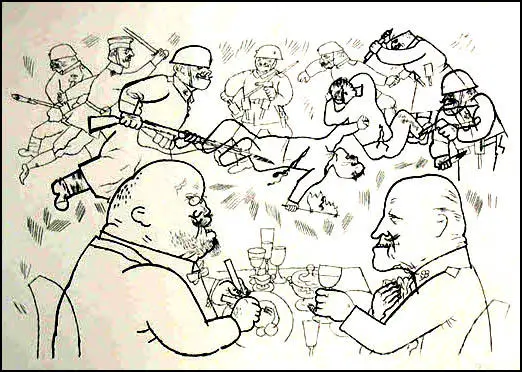
Uwe M. Schneede, the author of George Grosz: His Life and Work (1979) has pointed out that the drawing was inspired by a phrase used by Rosa Luxemburg during the First World War: "Grosz links military action against the workers with the economic interests of the ruling classes. These drawings are comments on the Marxist interpretation of history, made wholly convincing through the powerful characterisation of the facial expressions of those who order the murders and those who carry them out." (65)
George Grosz began contributing work to Die Neue Jugend, an arts journal published by his brother. His work was influenced by his friend, John Heartfield who had "developed a new very amusing style of using collage and bold typography". (66) Grosz helped him develop what became known as photomontage (the production of pictures by rearranging selected details of photographs to form a new and convincing unity). We... invented photomontage in my South End studio at five o'clock on a May morning in 1916, neither of us had any inkling of its great possibilities, nor of the thorny yet successful road it was to take. As so often happens in life, we had stumbled across a vein of gold without knowing it." (67)
In 1920 George Grosz, John Heartfield and Raoul Hausmann organised the Erste Internationale Dada-Messe in the Berlin gallery owned by Otto Burchard. It was a comprehensive manifestation of Dada (a movement consisted of artists who rejected the logic, reason, and aestheticism of modern capitalist society, instead expressing nonsense, irrationality, and anti-bourgeois protest in their works). Among the 174 works in the exhibition were pictures by Grosz, Heartfield, Hausmann, Otto Dix, Max Ernst, Hannah Höch and Rudolf Schlichter. "The text on the panels accompanying each exhibit was partly Dadaist-polemical, partly political." (68)
In 1922 Grosz traveled to the Soviet Union with the Danish writer Martin Andersen Nexø. Upon their arrival in Murmansk they were briefly arrested as spies; after their credentials were approved, they were allowed to meet with Lenin and other revolutionary leaders such as Grigory Zinoviev and Anatoly Lunacharsky. Grosz's six-month stay in the Soviet Union left him unimpressed by what he had seen. (69) On his return he left the KPD, but he remained a committed socialist revolutionary. (70) After spending time in the Soviet Union he could "no longer subscribe to the positive image of the happy, liberated worker". (71)
Grosz wrote in his autobiography about how the political situation had changed the role of the artist: “All moral codes were abandoned. A wave of vice, pornography and prostitution enveloped the whole country.... The streets became ravines of manslaughter and cocaine traffic, marked by steel rods and bloody, broken chair legs.” (72) In 1923 he published the book, Ecce Homo. It contained 84 offset lithographs and 16 watercolor reproductions. "The book is a vicious satire of post-war German life, with politicians, capitalists, prostitutes, mutilated veterans, beggars, and drunks in various states of despair, lust, and rage. The German government banned it and Grosz was put on trial for public offense. While he was clearly influenced by the Cubist, Bauhaus, and Fauvist movements, in Ecce Homo, Grosz’s raw, angry style is distinctly his own." (73)
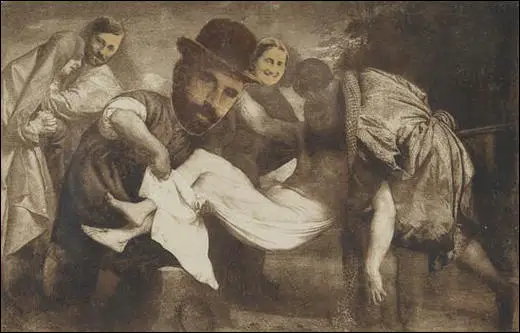
Lisa Small has argued: "Cynicism and disillusionment with the government and militarism permeates the work of George Grosz, an incisive caricaturist, satirist, and one of the most influential graphic artists to be associated with Expressionism, New Objectivity, and Dada. An ardent communist and supporter of the working class, Grosz expressed his disdain for the right wing capitalist and military ruling classes in a caustic portfolio of lithographs he made after WWI ironically titled God With Us after the nationalistic motto inscribed on every German soldier’s belt buckle. The print For German Right and German Morals presents five brutish, malevolent, and corrupt specimens of the German military; the squat and thuggish officer in the center, whose holster makes obvious reference to his genitals, crushes a flower under his boot." (74)
In one case Grosz was charged with blasphemy for his cartoon of Christ in a gas-mask. Mary M. Lane claimed that this was a warning against radical far-right religious views... a work that shows Jesus Christ nailed to the cross wearing combat boots and a gas mask - a criticism of politicizing Christianity that drew praise from pacifist Quakers in the United States." (75)
Frank Whitford has argued that the work of artists such as George Grosz and Otto Dix developed what became known as the New Realism. "They had grown weary of the years of hectic experimentation that had preceded the war and that they were tired of all kinds of art that were highly subjective, metaphysical, esoteric and accessible only to an elite. They wanted to return to subjects that were familiar to everyone, painted in a way which everyone could understand. Some of them were content simply to mirror common experience of mundane things. Others, more politically inspired, preferred to angle the mirror so that the dark side of society was revealed. All of these artists cultivated a painstakingly realistic style which emulated the smooth, anonymous surface of the photograph." (76)
George Grosz gained support from Bertolt Brecht: "Let us suppose that the trial of Socrates is over. We organize a short witches' trial, where the judges are armoured knights who condemn the witch to the stake. Then the trial of George Grosz begins, but we forget to remove the knights from the stage. When the indignant prosecutor storms at the artist for having insulted our mild and compassionate God... the knights... are moved to applause." (77)
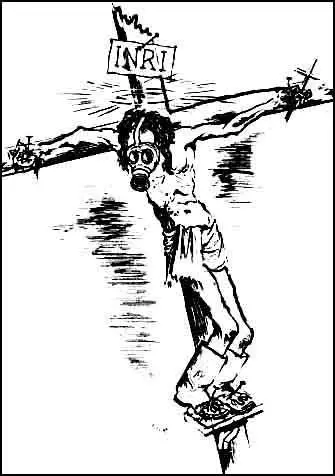
George Grosz and John Heartfield joined with Paul Levi, Willie Munzenberg, Clara Zetkin, Ernst Toller, Walther Ulbricht, Heinrich Blücher, Julian Marchlewski, Ernst Thälmann, Hermann Duncker, Hugo Eberlein, Paul Frölich, Wilhelm Pieck, Franz Mehring, and Ernest Meyer. to form the German Communist Party (KPD). Over the next fifteen years Grosz and Heartfield produced designs and posters for the organization. (78) Grosz participated in the First International Dada Fair of 1920. Grosz's collected drawings, The Face of the Ruling Class was published in 1921. It is claimed that Grosz and Heartfield had a major influence on the German Dada group that included Otto Dix, Max Ernst, Raoul Hausmann and Kurt Schwitters. (79)
In 1925 Grosz started painting in oils again. The subject of his first portrait was Max Herrmann-Neisse, a poet and fellow left-wing activist. Herrmann-Neisse became a great supporter of the work of Grosz. He later wrote: "I always felt perfectly at home with George Grosz. We had roughly the same convictions and moods... We were both poets as well as cynics, at once correct and anarchic. I sat for him innumerable times with the greatest of pleasure, feeling blissfully secure in his studio... Leaning against the walls were the pictures which for the decent citizen represented a veritable chamber of horrors. The painstaking way in which he worked on my portrait demonstrated how very seriously he took his work." (80)
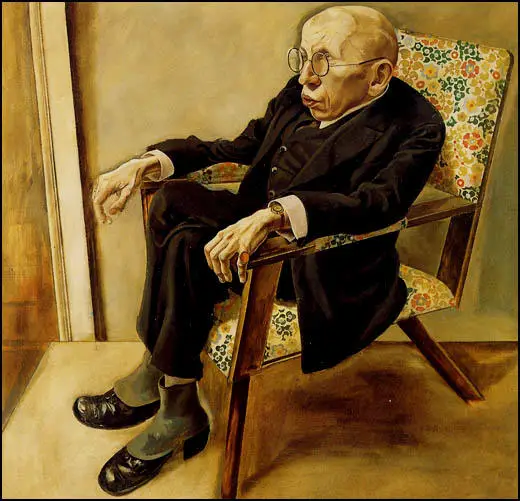
George Grosz disliked post-war Germany and the excesses of city life. "My drawings and paintings were done as an act of protest; I was trying by means of my work to convince the world that it is ugly, sick and hypocritical... I drew drunks, people throwing up, men shaking their fists at the moon as they cursed it, the murderers of women, playing at cards while sitting on a crate in which the murder victims could be seen... I drew a man looking around him fearfully, washing his hands, which had blood on them." (81)
Grosz’s first large painting was Eclipse of the Sun (1926). The painting is a scathing indictment of the military-industrial complex and of materialism: We see two men on the right of the picture; one is covered in medals and decorations and huge epaulettes, obviously a military man; the one next to him on the other hand looks more like a businessman or profiteer wearing a bowler hat and with a train of guns mounted on his suit. The other people in the picture have no heads, as if they were stuffed shirts made to do anything except what they are told." (82)
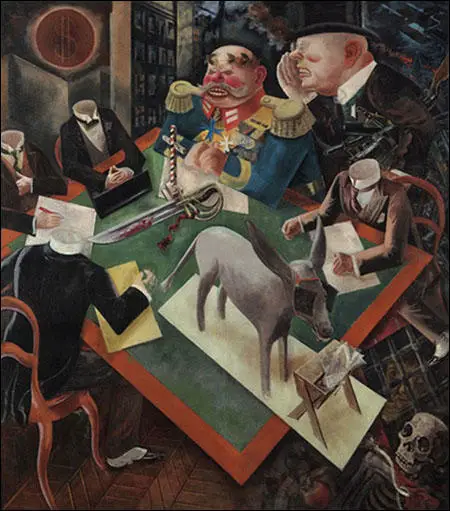
In 1928 Grosz was charged with blasphemy. During his trial he said: "It is a long German tradition which I carry on. When the times are very troubled, when the foundations are shaken, the artist cannot stand aside, especially not the talented artist with his greater sensitivity. That is why, without wanting to, he will be political... There is much injustice and it is a certain inner compulsion which has driven me to the side of those who are struggling against this injustice. I think there is too much brutality and not enough love. Wherever one turns, there are empty words, injustice and brutality. Surely there exists a minority which feels that too. To tell the truth, these feelings are alive, they animate any man who is of a satirical turn of mind." (83)
Grosz also designed sets or costumes for seven productions at Berlin theatres including those of Erwin Piscator. Grosz wrote in his journal that "Erwin has created a great new era for the graphic artist to work in, a veritable graphic arena, more tempting for graphic artists of today than all that stuffy aesthetic business or the hawking around of drawings in bibliophile editions for educated nobs... What a medium, though, for the artist who wants to speak to the masses, purely and simply. Naturally a new area requires new techniques, a new clear and concise language of graphic style - certainly a great opportunity for teaching discipline to the muddleheaded and confused!" (84)
It has been argued that Grosz became one of the most important artists in the world during this period: "Grosz's work as graphic artist, painter, and designer of costumes and stage sets, along with his involvement as co-founder and advocate of new artistic movements, teacher, writer, and political commentator, all underline his versatility. At the centre of his oeuvre, however, stand his political, critically-engaged drawings; it is through them that Grosz became famous... For long phases within his creative output, Grosz saw himself less as an artist than as an aggressive pictorial journalist." (85)
George Grosz, along with John Heartfield and Karl Arnold, were the first artists to realise the dangers of Adolf Hitler. Originally drawn in 1923, but not published until 1930, Hitler, the Saviour, is a change in style for Grosz: "Drawn in the year of Hitler's failed putsch in Bavaria in 1923, told a different story. Grosz's Hitler is a more human figure but divided against himself... who had a necklace of teeth around his neck and wore a furry shift, would not have plastered his hair down so carefully, and cut his moustache in such an odd way. There was a smug and belligerent expression on Hitler's face, an expression which should not have been on the face of one of the heroes of the great German myth... There was a dangerous, downward curve about Hitler's mouth. Grosz was pointing out Hitler's mysticism and its underlying banality, in a way only possible for someone who was familiar with the phenomenon, having observed it closely in its own setting." (86)
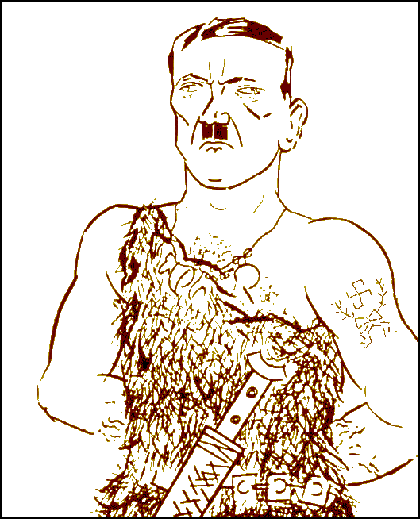
In 1930 George Grosz illustrated The Three Soldiers, a children's book by Bertolt Brecht. "The soldiers realised 'that it was a war of the rich and the rich made war only in order that the rich should grow still richer'. The soldiers were called Hunger, Disaster and Disease. They travel across the country, killing as they go along. When they get to Moscow they are shot because there people are unwilling to put up with wretchedness." (87)
Grosz continued to grow worried about the growth in the Nazi Party: "Perhaps what lies ahead of us is the new Middle Ages. At least to me humanist ideas seem to be dying out, just as... human rights are no longer greatly valued. Rather it would appear that hand in hand with the progress of civilisation goes a sound contempt for human life." (88) However, most Germans dismissed Grosz’s anti-Nazi work as hyperbolic and offensive to Christianity, a feeling that far-right activists exploited to distract from what he was saying. One night in the early 1930s, Grosz discovered an iron pipe at his front door with a note attached. “This is for you, you old Jew-Pig, if you keep going with what you’re doing." (89)

In June 1932, he accepted an invitation to teach the summer semester at the left-wing Art Students League in New York City . In October 1932, Grosz returned to Germany, but on January 12, 1933, he and his family emigrated to the United States. "On 30th January, 1933, Hitler became Germany's Reich Chancellor... Soon letters arrived from which I learnt that they had been looking for me in my empty flat in Berlin, and also in my studio. I venture to doubt whether I should have got away with my life." (90)
Grosz became one of over 2,500 artists and writers to leave Nazi Germany. Grosz continued to attack Hitler in his work. This includes the drawing, He is a Writer (1933). In this drawing Grosz depicts the SA searching through the belongings of a terrified suspect: "He is a writer", they declare. It has been suggested that Hitler's almost fanatical hatred of intellectuals and the educated middle-class can perhaps be traced to his own academic failure and early rejecting of intellectual discipline." (91)
According to Uwe M. Schneede: "Letters, reports and drawings from his early days in America bore witness to Grosz's fascination with the casualness of the Americans, with their shows, their fashions, the speed of their lives... There are many sketches and drawings in which he registered these fresh impressions, his determined turning to American themes running parallel with a total turning away from the political works he had created in Germany... Grosz wanted to become an American illustrator but he failed in this intention. Cut off from his own culture, he remained an alien in exile who did not quite manage to adapt to his new life." (92)
However, when he heard that his friends in Germany were being arrested and being imprisoned in concentration camps, Grosz once again returned to political themes. In 1934 he produced He was a writer, about the death of Erich Mühsam in Oranienburg Concentration Camp. Another friend, Hans Borchardt, was interned in Dachau Concentration Camp before escaping to America: "The camp seemed to him like some kind of hell where those sharing damnation did not by any means share solidarity. Those strapped up together had become perfectly transparent like gelatine, their screams wrapped round with straw. Altogether things were very quiet there, much quieter than in the real world. Even the sub-machine guns had silencers." (93)
Grosz later wrote: "Many things that in Germany had frozen inside me now began to melt, and in America I discovered once again my delight in painting. Deliberately and with great care I burnt a part of my past... If temporarily I suffered from deep depressions, that had nothing to do with America. It was like some threatening flash of summer lightning, like far-away conflagrations and the smell of blood. I painted these visions of ruins in which the fire was still raging. That was long before the war." (94)
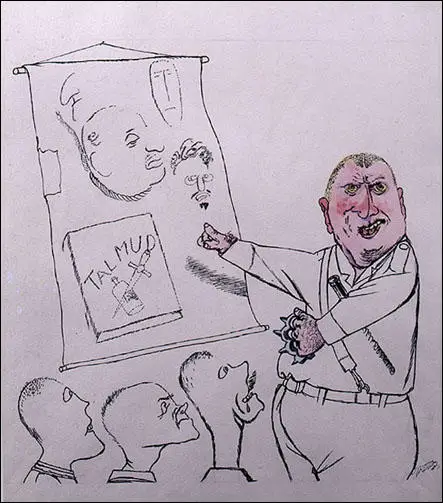
In 1936 a New York publisher brought out a volume of recent Grosz drawings. Several of these dealt with the subjects of the anti-Semitism and anti-Bolshevism of Hitler's government. In one drawing, The Letter to an Anti-Semite (1935), Grosz "shows a teacher demonstrating to his chained pupils a picture of the enemy, a blood-dripping Jewish Bolshevik, while next to it hangs the ideal of the upright German complete with a sword and palm leaf." (95) In 1938 Grosz became an American citizen. (96)
On 27th November, 1936, Joseph Goebbels issued the following decree: "On the express authority of the Führer, I hereby empower the President of the Reich Chamber of Visual Arts, Professor Ziegler of Munich, to select and secure for an exhibition works of German degenerate art since 1910, both painting and sculpture, which are now in collections owned by the German Reich, by provinces, and by municipalities. You are requested to give Professor Ziegler your full support during his examination and selection of these works." (97)
It is estimated that 285 of George Grosz's works were confiscated. Other artists who suffered included Emil Nolde (1,052), Erich Heckel (729), Karl Schmidt-Rottluff (688), Ernst Ludwig Kirchner (639), Max Beckmann (509), Christian Rohlfs (418), Oskar Kokoschka (417), Lyonel Feininger (378), Ernst Barlach (381), Otto Müller (357), Karl Hofer (313), Max Pechstein (326), Lovis Corinth (295), Otto Dix (260), Franz Marc (130), Paul Klee (102), Paula Modersohn-Becker (70) and Kathe Kollwitz (31). The campaign against "degenerate art" took in work by 1,400 artists in all. (98)
The Exhibition of Degenerate Art opened in Munich on 19th July, 1937. It included 650 works of art confiscated from 32 German museums. The exhibition travelled to twelve other cities from 1937 to 1941. In all, the show drew more than 3 million visitors. The exhibition sought to demonstrate the “degeneration” of artworks by placing them alongside drawings done by the mentally retarded and photographs of the physically handicapped. Grosz's work was placed in a section that were considered to be "art as a tool of Marxist propaganda against military service". It was claimed that in these works "German soldiers were depicted as idiots, sexual degenerates and drunks." (99)
It has been argued that after George Grosz arrived in America, his importance as an artist went into decline. There are several reasons for this. One concerned his "disappointment about the powerlessness of art in the face of politics". With the success of fascism in Germany made "him aware of the futility of his years of political commitment, particularly against German militarism". Secondly, "yet harder still than this defeat was the suffering which Grosz inflicted upon himself, arising from the boundless hatred which both he and others have diagnosed again and again in his works. For years this hatred was the source of his artistic powers of expression." While living in America he began searching for "new creative impulses - a search that was ultimately to prove futile." (100)
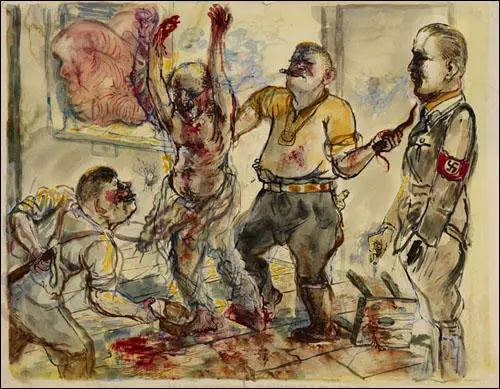
His friend Ernst Toller, also escaped to America. However, he committed suicide in his hotel room in New York City on 22nd May, 1939. "Toller had been found by his secretary, hanging from his bathroom door in a Manhattan hotel. It was said that he must have been thinking of suicide for some time, and that he had had several strange conversations with friends concerning the workings of gas stoves and taps. He had long been suffering from depression; everything seemed to be going wrong for him, and since the Loyalist collapse in Spain he had ceased to be his old self." (101)
In 1946 he wrote: "My pictures are witnesses of my inner world, a world which it is hard to photograph, so that my pictures do not compete with the camera or the newsreel. I create my own fearful fairytale world, full of ruins and populated with ugly dwarfs, frightening superhuman creatures and wicked magicians." (102) The following year he was offered a professorship at the Berlin School of Art. He refusing and told a friend he would rather be poor and a failure in America than a failure and poor in Germany. (103)
George Grosz published his memoirs, The Autobiography of George Grosz in 1955. George Grosz returned to Germany in 1959, saying "My American dream turned out to be a soap bubble". A few days later, on 6th July. "after a night out with friends, the inebriated artist slipped on the stairs of his apartment, dying in the hallway from the injuries". (104)
Otto Dix
Otto Dix, the eldest son of Franz Dix (1862-1942), an iron foundry worker, and Louise Amann (1864-1953), a seamstress, was born in Unternhaus, Germany, on 2nd December, 1891. He spent a lot of time with his cousin, Fritz Amann, who was attempting to make a living as an artist. (105)
After attending elementary school he worked locally. In 1906 he started an apprenticeship with painter Carl Senff, and began painting his first landscapes. In 1910 he became a student at the Dresden School of Arts and Crafts. To help fund his education, he accepted commissions and painted portraits of local people. (106)
On the outbreak of the First World War in 1914 Dix volunteered for the German Army and was assigned to a field artillery regiment in Dresden. He later recalled why he joined the army: "I had to experience how someone beside me suddenly falls over and is dead and the bullet has hit him squarely. I had to experience that quite directly. I wanted it. I'm therefore not a pacifist at all - or am I? - perhaps I was an inquisitive person. I had to see all that for myself. I'm such a realist, you know, that I have to see everything with my own eyes in order to confirm that it's like that. I have to experience all the ghastly, bottomless depths for life for myself; it's for that reason that I went to war, and for that reason I volunteered." (107)
In the autumn of 1915 Dix was sent to the Western Front where he served as a non-commissioned officer with a machine-gun unit. He was at the Somme during the major allied offensive during the summer of 1916. Dix was wounded several times during the war. On one occasion he nearly died when a shrapnel splinter hit him in the neck. His experiences on the front line had a dramatic impact on his art: "War is so bestial: hunger, lice, mud, those insane noises... I had the feeling, on looking at the pictures from my early years, that I had completely missed one side of reality so far, namely the ugly aspect." (108)
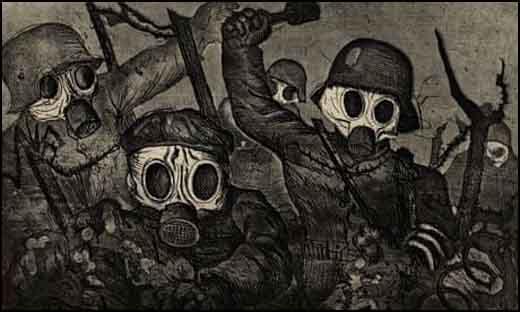
In November 1917 his unit was transferred to the Eastern Front and after Russia negotiated a peace with Germany, Dix returned to France where he took part in the German Spring Offensive. In August of that year he was wounded in the neck. By the end of the war in 1918, Dix had won the Iron Cross (second class) and reached the rank of vice-sergeant-major. He was discharged from service on 22nd December 1918. (109)
After the war Dix developed left-wing views and his paintings and drawings became increasingly political. Like other German artists such as John Heartfield and George Grosz, Dix became what they called "revolutionary pacifists". As Jonathan Jones has pointed out: "It was not at all obvious that a man such as Dix would create some of the defining pacifist images of the 20th century. In 1914 he was a fierce German patriot who joined up enthusiastically. He became a machine gunner and fought at the Battle of the Somme, efficiently mowing down British troops. He won the Iron Cross (second class) and began training to be a pilot. How did this courageous soldier turn into an anti-war artist? To understand that, we need to comprehend that, during the first world war, a radical minority of Germans turned to artistic and political revolution, rather than nationalism. Like the British war poets, Germany's young artists came to hate the war, but unlike the poets, they organised to resist it." (110)
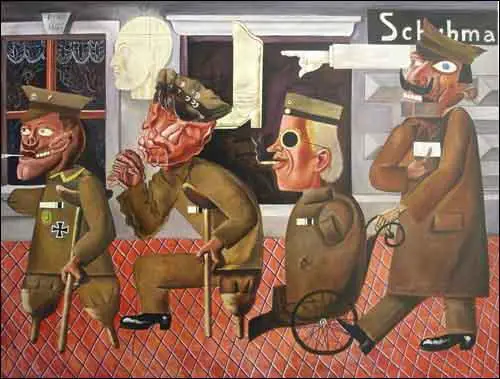
Otto Dix told Maria Wetzel: "As a young man you don't notice at all that you were, after all, badly affected. For years afterwards, at least ten years, I kept getting these dreams, in which I had to crawl through ruined houses, along passages I could hardly get through. Not that painting would have been a release. The reason for doing it is the desire to create. I've got to do it! I've seen that, I can still remember it, I've got to paint it." (111)
It has been argued by Uwe M. Schneede that Otto Dix was one of the founders of modern Verism (the artistic preference of contemporary everyday subject matter instead of the heroic or legendary in art): "From the garish over-emphasised effects of his Dadaist beginnings he came via the study of the art of previous centuries - especially of old German masters and their technique - to his ponderously constructed pictures, precise in every detail, in which the object is kept balanced between an almost aggressive here-and-now and a removal from reality." (112)
One of his most powerful paintings was The Skat Players (1920). Influenced by the work of John Heartfield, it shows "card-playing cripples... a nightmarish vision of people so mutilated that the scarred remains are scarcely human. Arms, legs, jaws, ears and noses shot away, these men function only as a series of spare parts cobbled together, and their construction is paralleled in the way the picture has been made: it is an elaborate collage, the painted parts combined with glued-on playing-cards, newspapers and bits of wood." (113)
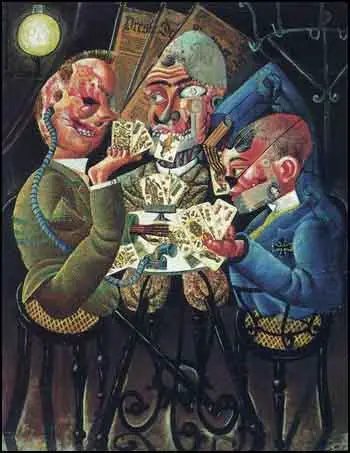
In 1920 George Grosz, John Heartfield and Raoul Hausmann organised the Erste Internationale Dada-Messe in the Berlin gallery owned by Otto Burchard. It was a comprehensive manifestation of Dada (a movement consisted of artists who rejected the logic, reason, and aestheticism of modern capitalist society, instead expressing nonsense, irrationality, and anti-bourgeois protest in their works). Among the 174 works in the exhibition were pictures by Dix, Grosz, Heartfield, Hausmann, Max Ernst, Hannah Höch and Rudolf Schlichter. "The text on the panels accompanying each exhibit was partly Dadaist-polemical, partly political." (114)
Dix was angry about the way that the wounded and crippled ex-soldiers were treated in Germany. This was reflected in paintings such as War Cripples (1920), Butcher's Shop (1920) and War Wounded (1922). In October, 1923 Dix's large painting, The Trench, was purchased by the Wallraf-Richartz Museum. The museum's director, Hans F. Secker, assured him that it had been acquired "not without blood and sweat". He added that when the new collection was to be opened to the public in December "your painting will most likely be the greatest sensation." (115)
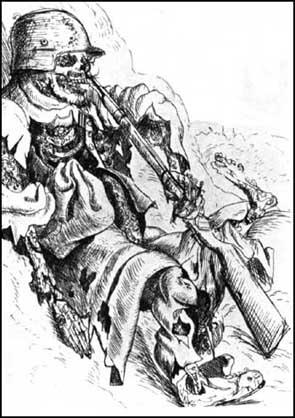
Walter Schmits, writing in The Kölnische Zeitung, commented: "In the cold, sallow, ghostly light of dawn…a trench appears into which a devastating bombardment has just descended. A poisonous sulphur yellow pool glistens in the depths like a smirk from hell. Otherwise the trench is filled up with hideously mutilated bodies and human fragments. From open skulls brains gush like thick red groats; torn-up limbs, intestines, shreds of uniforms, artillery shells form a vile heap... Half-decayed remains of the fallen, which were probably buried in the walls of the trench out of necessity and were exposed by the exploding shells, mix with the fresh, blood covered corpses. One soldier has been hurled out of the trench and lies above it, impaled on stakes." (116)
When the painting was exhibited in 1924 its depiction of decomposed corpses in a German trench created such a public outcry that the museum's director hid the painting behind a curtain. The local newspaper demanded that the painting should be returned to the artist. Whereas a journalist claimed that the painting had received so much publicity that it had increased the number of people who had seen it. Another critic described it as "perhaps the most powerful as well as well as the most anti-war statements in modern art". In 1925 the then-mayor of Cologne, Konrad Adenauer, cancelled the purchase of the painting and forced Secker to resign. (117)
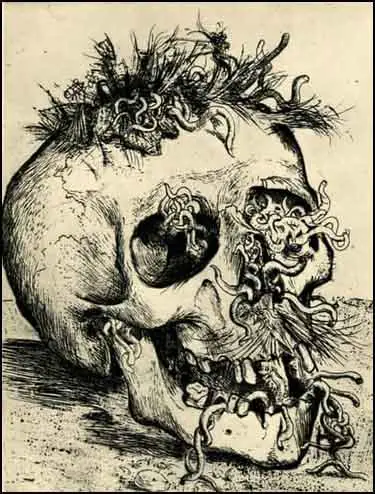
During the First World War, Dix had limited opportunities to paint pictures. However, he did make a large number of sketches. In 1924 Dix joined with other artists who had fought in the First World War to put on a travelling exhibition of paintings called No More War! Dix also produced a book of etchings, The War (1924). Tom Lubbock described the book as "a series of astonished snapshots, each of which might have the motto: I can't believe that I saw this, but I did." (118)
Hilton Kramer, argued that the people who visited the exhibition would have found it a difficult experience: "The total effect of these images of violence, suffering and death is so grim and so powerful that it’s likely to leave more tender-hearted visitors to the exhibition reeling from the experience. Even though we read about similar horrors in the newspapers every day... such graphic depictions of violent death remain far more disturbing than the printed word." (119)
Another critic commented: "A German soldier sits in a trench, resting against its muddy wall. He is smiling, but the grin is empty and hollow-eyed – for his face is a bare skull. He has been dead a while. No one bothered to bury him. His helmet is still on his skull, and his boots reveal a rotting ankle. In another print, a severed skull lies on the earth. Grass has grown on its crown. More grass resembles a moustache under its nose. Out of the eyes, vegetation bursts. Worms crawl sickeningly out of a gaping mouth." (120)
Frank Whitford has argued that the work of artists such as Otto Dix, developed what became known as the New Realism. "They had grown weary of the years of hectic experimentation that had preceded the war and that they were tired of all kinds of art that were highly subjective, metaphysical, esoteric and accessible only to an elite. They wanted to return to subjects that were familiar to everyone, painted in a way which everyone could understand. Some of them were content simply to mirror common experience of mundane things. Others, more politically inspired, preferred to angle the mirror so that the dark side of society was revealed. All of these artists cultivated a painstakingly realistic style which emulated the smooth, anonymous surface of the photograph." (121)
Dix's artist friends such as George Grosz and John Heartfield joined with Paul Levi, Willie Munzenberg, Clara Zetkin, Ernst Toller, Walther Ulbricht, Heinrich Blücher, Julian Marchlewski, Ernst Thälmann, Hermann Duncker, Hugo Eberlein, Paul Frölich, Wilhelm Pieck, Franz Mehring, and Ernest Meyer. to form the German Communist Party (KPD). Over the next few years Grosz and Heartfield produced designs and posters for the organization. (122) Dix had original agreed with them about politics but refused to join the KPD. When a friend asked him to join he replied: "I don't want to hear about your stupid politics - I'd rather spend the 5 marks' membership fee on a whore." (123)
Dix worked for six years on what is considered to be one of his two great masterpieces, Metropolis (1928). It is a triptych (a painting on three panels side by side). With "dazzling colour and great richness of invention, he embodied his vision of Berlin at the height of its frenzied decadence of the 1920s." In the left-hand panel, Dix shows himself as a war cripple entering Berlin and being greeted by a row of beckoning prostitutes. "Bleating saxophones coax customers on to the dance floor. The whores outside tell beggars to get lost and a man with a prosthetic jaw, give a mock salute top passing transvestites." (124)
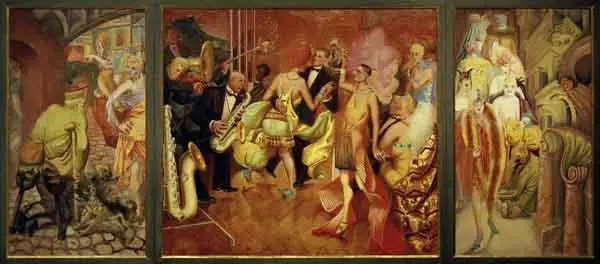
Dix's experiences in the First World War served to make him particularly sensitive to the hypocrisy of post-war bourgeois society, a hypocrisy which he recognized as the product of mental suppression. "People did not want to see the innumerable war cripples lining the streets, not wishing to be reminded of the disastrous years. People dressed up, donned masks, did anything to avoid being themselves, and lost themselves in the temples of pleasure. Dix created a monument to this society in his Metropolis Triptych, one pushed to extremes through its employment of the sacred form of the triptych." (125)
Otto Dix became preoccupied with the violent excesses of city life in the Weimar Republic. "He came to believe that everyday crime was the reflex to and continuation of the lunacy of war: The catastrophe had began. I drew drunks, people throwing up, men shaking their fists at the moon as they cursed it, the murderers of women, playing at cards while sitting on a create in which the murder victims could be seen... I drew a man looking around him fearfully, washing his hands, which had blood on them." (126)
In 1927 Otto Dix was given a professorship at the Dresden School of Arts and Crafts. His interest during this period was focused solely upon people. Only in extremely rare instances were his portraits commissioned works. Instead he embarked on a constant search for personalities who could provide information about their time. He sought models in cafe, in the street, and within his circle of friends who would reflect the changes taking place in society. (127)
Sylvia von Harden, the journalist, recalls how Dix met her in the street: "I must paint you! I simply must! You are representative of an entire epoch! So, you want to paint my lack-luster eyes, my ornate ears, my long nose, my thin lips; you want to paint my long hands, my short legs, my big feet - things which can only scare people off and delight no-one? You have brilliantly characterized yourself, and all that will lead to a portrait representative of an epoch concerned not with the outward beauty of a woman but rather with her psychological condition." (128) The portrait shows von Harden with bobbed hair and monocle, seated at a cafe table with a cigarette in her hand and a cocktail in front of her. (129)
Ernst Friedrich, published his book of photographs of German soldiers who had been badly disfigured by warfare. Dix made extensive use of these photographs when he returned to the subject of war. In 1928 he said: "People were already beginning to forget what horrible suffering the war had brought them." He completed the second of his masterpieces, Trench Warfare in 1932. It was a painting that attempted to drain war of any heroism or nobility. (130)
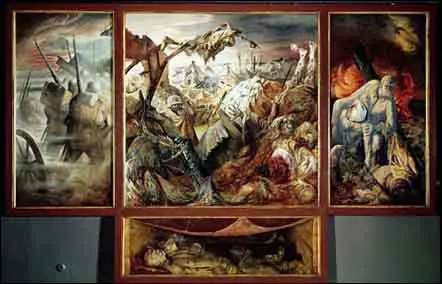
Trench Warfare, like his other masterpiece, Metropolis (1928) is a triptych. Very popular in medieval times, this form was usually used to make altar-pieces. It has three main panels, with a fourth as a supporting panel or predella below the main central panel. This panel is based on The Body of the Dead Christ in the Tomb by Hans Holbein.The large central panel is a 204 cm (80 in) square; the flanking panels to either side the same height but half the width, 102 cm (40 in) each; and the predella below the central panel has the same width but is only 60 cm (24 in) high. The left-handed panel shows German soldiers marching off to war, the central panel is a scene of destroyed houses and mangled bodies, and the right-hand panel side panel shows soldiers struggling home from the war. (131)
On 4th January, 1933, Adolf Hitler had a meeting with Franz von Papen and decided to work together for a government. It was decided that Hitler would be Chancellor and Von Papen's associates would hold important ministries. "They also agreed to eliminate Social Democrats, Communists, and Jews from political life. Hitler promised to renounce the socialist part of the program, while Von Papen pledged that he would obtain further subsidies from the industrialists for Hitler's use... On 30th January, 1933, with great reluctance, Von Hindenburg named Hitler as Chancellor." (132)
Most of his artistic friends, including George Grosz and John Heartfield, fled Nazi Germany. As Dix had not been critical of Hitler he thought he would be safe. He justified his non-political stance by the words: "Artists shouldn't try to improve and convert they're far too insignificant for that. They must only bear witness." However, Hitler hated Dix's anti-war paintings and he was sacked as professor at the Dresden School of Arts and Crafts. Dix's dismissal letter said that his work "threatened to sap the will of the German people to defend themselves." (133)
Otto Dix continued to paint pictures about the First World War. An example of this was Flanders (1934), a painting that shows a scene from the Western Front. Dix later claimed was Inspired by a passage from Under Fire, a novel written by the French soldier, Henri Barbusse. In the picture dead bodies float in water-filled shell-holes while those soldiers still alive resemble rotting tree stumps. "The central figure, a soldier, shelters behind a tree stump, trying to snatch some sleep before once more going into battle. The landscape is completely obliterated, leaving only destroyed buildings and trees, and water-filled shell craters. All around are dead, wounded or exhausted men, who lie or sit in a morass of mud while the sky appears to bear down on them, dark but for the restricted orange glow of the sun." (134)
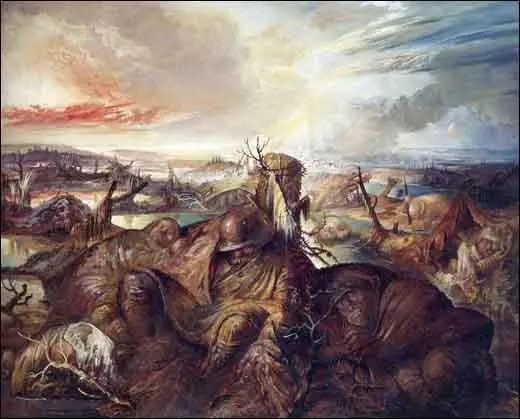
On 27th November, 1936, Joseph Goebbels issued the following decree: "On the express authority of the Führer, I hereby empower the President of the Reich Chamber of Visual Arts, Professor Ziegler of Munich, to select and secure for an exhibition works of German degenerate art since 1910, both painting and sculpture, which are now in collections owned by the German Reich, by provinces, and by municipalities. You are requested to give Professor Ziegler your full support during his examination and selection of these works." (135)
It is estimated that 260 of Otto Dix's works were confiscated. "He was despised by Hitler not just because he drew and painted in a spiky, gnarled, ghoulish way that decried the ravages of World War I and spoke to Weimar anxiety, but because his art mocked the German idea of heroism. The Munich self-portrait conveys a pride that seems ready to vanquish an enemy that had not quite appeared on the scene when Dix painted the work in 1919 but that both he and his art would outlast." (136)
Other artists who suffered included Emil Nolde (1,052), Erich Heckel (729), Karl Schmidt-Rottluff (688), Ernst Ludwig Kirchner (639), Max Beckmann (509), Christian Rohlfs (418), Oskar Kokoschka (417), Lyonel Feininger (378), Ernst Barlach (381), Otto Müller (357), Karl Hofer (313), Max Pechstein (326), Lovis Corinth (295), George Grosz (285), Franz Marc (130), Paul Klee (102), Paula Modersohn-Becker (70) and Kathe Kollwitz (31). The campaign against "degenerate art" took in work by 1,400 artists in all. (137)
The Exhibition of Degenerate Art opened in Munich on 19th July, 1937. It included 650 works of art confiscated from 32 German museums. The exhibition travelled to twelve other cities from 1937 to 1941. In all, the show drew more than 3 million visitors. The exhibition sought to demonstrate the “degeneration” of artworks by placing them alongside drawings done by the mentally retarded and photographs of the physically handicapped. Dix's work was placed in a section that were considered to be "art as a tool of Marxist propaganda against military service". It was claimed that in these works "German soldiers were depicted as idiots, sexual degenerates and drunks." (138)
Dix, like all other artists, was forced to join the Nazi government's Reich Chamber of Fine Arts (Reichskammer der bildenden Kuenste), a subdivision of Goebbels' Cultural Ministry (Reichskulturkammer). Membership was mandatory for all artists in the Reich. Otto Dix had to promise to paint only inoffensive landscapes or portraits. According to one of his biographers, Otto Conzelmann, Dix still painted an occasional allegorical painting that criticized Nazi ideals. (139)
In 1939 Otto Dix was arrested and charged with involvement in a plot on Hitler's life that had taken place in Munich. . However, he was eventually released and the charges were dropped. In the Second World War Dix was conscripted into the Volkssturm (German Home Guard). In 1945 Dix was forced to join the German Army and at the end of the war was captured by the French Army and was put into a prisoner-of-war camp. (140)
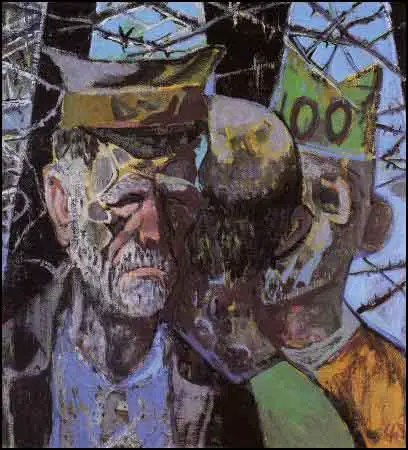
Released in February 1946, Dix returned to Dresden, a city that had been virtually destroyed by heavy bombing. Most of Dix's post-war paintings were religious allegories. However, paintings such as Job (1946), Masks in Ruins (1946) and Ecce Homo II (1948) dealt with the suffering caused by the Second World War. He also painted the anguished Self Portrait as Prisoner of War (1947) in which the barbed wire evokes the crown of thorns of the Crucifixion. (141)
Otto Dix died on 25th July, 1969.
Käthe Kollwitz
Käthe Schmidt, the daughter of Katharina and Karl Schmidt, was born in the industrial city of Königsberg, on 8th July 1867. Her father was a stone mason and house builder, who developed strong socialist opinions after reading the work of Karl Marx. Her mother was the daughter of Julius Rupp, a nonconformist religious leader who suffered much political abuse. (142)
She was a "quiet, shy and nervous" child and spent most of her time with her older siblings, Julie and Konrad: "There were endless places to play and numerous adventures to be had in those yards. For example, a pile of coal had been unloaded from a boat and dumped in the yard in such a way that it sloped up gently and then fell off sharply on the side facing our garden. It was a risky matter to climb up almost to the brink. I myself never dared, but Konrad did. Another boy who tried it was hurt." (143)
Karl Schmidt was educated to become a lawyer but had not followed his profession because his political, social, and moral views made it impossible for him to serve what he considered to be the authoritarian government led by Otto von Bismarck. He joined the Social Democratic Party (SDP). According to Martha Kearns: "Schmidt was a man of the future in his educational as well as political views. Unlike many Prussian fathers... the head of the Schmidt family was not a strict disciplinarian and he did not believe in corporal punishment. A moral idealist, he taught his children to correct their behaviour through self-control, choosing to guide rather than force their development.... In a day when girls were rarely encouraged to aspire to roles other than those of wife and mother, he personally helped to develop the individual talents of each of his three daughters." (144)
Käthe was also influenced by her grandfather who also held strong socialist beliefs and had been imprisoned because his religious views differed from those of Fredrich Wilhelm IV of Prussia. She later recalled: "He was always ready to give, was always kindly and informative, and often laconically humorous... He was tall, thin, dressed in black up to his chin, his eye-glasses having a faintly bluish tinge, his blind eye covered by a somewhat more opaque glass." (145)
Käthe greatly admired her grandfather: "I respected him, but was timid in his presence because I was a bashful child. I did not have the personal relationship with him which my two older sisters and, above all, my brother experienced. Along with the other children of the congregation I had religious instruction under him, an instruction which perhaps passed over the heads of most of the children, myself included. The teaching consisted of religious history, discussion of the gospels, and commentary on the Sunday sermon. A loving God was never brought home to us." (146)
It was very important to Karl Schmidt that his children grew up with a sympathy for the plight of the working-class. Käthe remembers her father reading the poem, The Song of the Shirt, written by the English poet, Thomas Hood. Käthe later explained that as her father "read the last lines, he became so moved that his voice grew fainter and fainter until he was unable to finish. His silent identification with the poor seamstress filled the room. In the silence Käthe, too, experienced the sweat, heat, and grind of a shirt factory and the working woman's numb fatigue." (147)
All three girls were gifted artists. The youngest daughter, Lise, was especially talented. One day Käthe overheard her father tell her mother that Lise's drawings were so good that she would "soon be catching up to Käthe". She wrote in her diary: "When I heard this I felt envy and jealously for probably the first time in my life. I loved Lise dearly. we were very close to one another and I was happy to see her progress up to the point where I began; but everything in me protested against her going beyond that point. I always had to be ahead of her." (148)
Her father became convinced that Käthe could become a great artist. In 1881 he arranged for her to have lessons with Rudolf Mauer, a local copper engraver. Käthe made drawings from plaster casts and copied drawings by famous artists. Käthe later recalled that her father and grandfather, Julius Rupp, were both important to her development: "Although I thought that Grandfather's religious force did not live on in me, a deep respect remained, a respect for his teachings, his personality and all the Congregation stood for. I might say that in recent years I have felt both Grandfather and Father within myself, as my origins. Father was nearest to me because he had been my guide to socialism, in the sense of the longed-for brotherhood of men." He once told her: "Man is not here to be happy, but to do his duty".Her grandfather died in 1884. (149)
The Schmidt family involvement with the Social Democratic Party (SDP) enabled Käthe to meet another young member, Karl Kollwitz. He was an orphan who lived with a family in Konigsberg. Like her father he was passionately interested in politics and introduced her to the writings of August Bebel. This included his pioneering work, Woman and Socialism (1879). In the book Bebel argued that it was the goal of socialists "not only to achieve equality of men and women under the present social order, which constitutes the sole aim of the bourgeois women's movement, but to go far beyond this and to remove all barriers that make one human being dependent upon another, which includes the dependence of one sex upon another." (150)
Käthe was particularly impressed with one passage of the book that stated: "In the new society women will be entirely independent, both socially and economically... The development of our social life demands the release of woman from her narrow sphere of domestic life, and her full participation in public life and the missions of civilisation." Bebel also predicted the dissolution of marriage, believing that socialism would free women from their second-class status. (151)
At the age of sixteen Käthe tried to enter the Königsberg Academy of Art. However, as a female, her application was rejected and so her father arranged for her to study under the painter, Emil Neide. He introduced her to work of the French artist, Gustave Courbet, who was the leader of the realist movement. Influenced by this attempt to capture the reality of everyday life, she completed The Emigrants, a work that had been inspired by a poem of that name by Ferdinand Freiligrath. (152)
In 1884 Karl Schmidt arranged for Käthe and Lise to visit Berlin. While in the city they stayed with their elder sister, Julie, and her husband. He was a close friend of the young poet and dramatist, Gerhart Hauptmann. He invited Käthe and Lise to a dinner party that was attended by two artists, Hugo Ernst Schmidt and Arno Holz. Hauptman described Käthe as "fresh as a rose in dew, a charming, clever girl, who, because of her extreme modesty, did not speak freely about her calling as an artist but let it be known by her sure, sensitive manner." Käthe was also impressed with Hauptman: "It was an evening that left its mark... a wonderful foretaste of the life which was gradually but irresistibly opening up for me." (153)
Karl Kollwitz became a medical student and in 1884 he asked Käthe to marry him. Her agreement to his proposal upset her father who feared that marriage would inhibit her artistic career. He arranged for her to study at the Berlin School for Women Artists, where she studied under Karl Stauffer-Bern. He introduced her to the work of Max Klinger. Käthe's biographer, Martha Kearns, has pointed out: "She (Käthe) had never heard of Max Klinger, Prussia's most skilled artist of the then-popular naturalism, a school of thought which deemed people to be predetermined victims in a bitter struggle for survival. As an art form, naturalism emphasized photo like images of actual persons, scenes, and conditions, often in the most minute, even microscopic detail. Unlike artists working in other styles, naturalist artists featured women as subjects as frequently as men." (154)
At Stauffer-Bern's suggestion, Käthe went to see Klinger's Ein Leben, at a Berlin exhibition. It was a series of fifteen etchings about a woman who had lost her virginity to her lover and who thus, in the eyes of the bourgeoisie, had "fallen" into unredeemable sin. The series reflected the double standard held against women at the turn of the twentieth century. This extremely accomplished and powerful series inspired Käthe and she wrote in her journal: "It was the first work of his I had seen, and it excited me tremendously." (155)
Käthe became friends with fellow art student, Emma Jeep. As women they were not allowed to attend life-drawing classes (this did not change in Berlin until 1893). At Käthe's request, Jeep often posed nude for her in the privacy of their rooms. The two women became close friends and this relationship lasted for the rest of Käthe life. At the time, Jeep was highly critical of Käthe's decision to get engaged. Jeep was a feminist and believed marriage would damage a woman's career as an artist. (156)
In her journal Käthe admitted that she was attracted to women: "Although my leaning toward the male sex was dominant, I also felt frequently drawn toward my own sex-an inclination which I could not correctly interpret until much later on. As a matter of fact I believe that bisexuality is almost a necessary factor in artistic production; at any rate, the tinge of masculinity within me helped me in my work." (157) Her biographer, Martha Kearns, has pointed out: "It is not known whether she ever acted on her feelings for women, whether she wanted to, or whether she would have been able to, considering her society's prohibitions and her own inhibitions." (158)
Käthe intended to continue her studies with Karl Stauffer-Bern but in 1888, Friedrich Welti, a very wealthy businessman, agreed to finance a stay in Rome for Stauffer-Bern. Soon afterwards, Stauffer-Bern, began a sexual relationship with his wife, Lydia Welti-Escher. When news of the relationship reached Welti, he used his government contacts to have Lydia committed to an asylum, and Stauffer-Bern was briefly sent to prison under trumped-up charges. On his release he committed suicide. (159)
In 1888 Käthe went to study at the Munich Women's Art School. She also joined the informal Composition Club, that met at the Glücks-Café. Other members included Otto Greiner, Alexander Oppler and Gottlieb Elster. Käthe impressed fellow members when she exhibited for the first time at the club. The drawings were illustrations of a coal miner's strike. That night she wrote in her journal: "For the first time I felt that my hopes were confirmed; I imagined a wonderful future and was so filled with thoughts of glory and happiness that I could not sleep all night." (160)
Käthe and Jeep also joined the Munich Etching Club. Later, Jeep described Käthe's first lesson: "The coal-black plate was now ready for drawing, so she found an empty table to work. Her right hand gripped the etching knife surely as she pressed it into the black wax. The manner in which she etched was much freer and more expressive than what they were used to; her etching looked more like a pen-and-ink drawing. Gradually the copper lines showed the face of an old man... The copper face shone out impressively from the blackened plate; she felt satisfied, and ready to etch... She continued to work industriously. Her style of secure and penetrating lines was already apparent." (161)
Käthe continued to take a keen interest in politics. She was impressed with the work of Karl Kautsky, who was considered the best interpreter of the theories of Karl Marx. She spent a lot of time with fellow artist, Helene Bloch, who had a studio in Königsberg. She recorded in her journal that "we had weekly get-togethers in my studio during which we read Kautsky's popularization of Marx's ideas." (162)
According to the author of Käthe Kollwitz (1976), Käthe gradually began to give up on painting: "By this time she was able to draw with pen, pencil, chalk, and charcoal; paint with ink and wash, and etch; but she could not lift the same scene intact onto canvas. Try as she might to perfect her painterly technique in the same way that she had mastered drawing and etching, she found that she had no feel for color or its great and subtle uses; nor did colour or nature inspire her in the same way as the lines and expressions of working people." (163)
In 1891 Karl Kollwitz qualified as a doctor and obtained a position in a working-class area of Berlin. In a response to the growing support of the Social Democratic Party (SDP), Otto von Bismarck had introduced the first European system of health insurance in which accident, sickness, and old age expenses of the workers and their families were covered by a government health insurance. As a socialist, Karl wanted to serve the poor and this new legislation made this possible. (164)
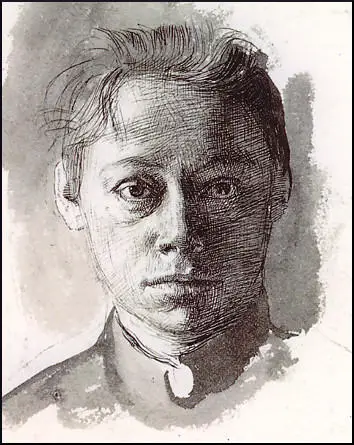
Karl Kollwitz now asked Käthe to marry him. Käthe recorded in her journal how disappointed her father had been by the news: "He had expected a much faster completion of my studies, and then exhibitions and success. Moreover, as I have mentioned, he was very skeptical about my intention to follow two careers, that of artist and wife." Shortly before her wedding on 13th June, 1891, her father told her, "You have made your choice now. You will scarcely be able to do both things. So be wholly what you have chosen to be." (165)
The couple moved to an apartment on 25 Weissenburger Strasse, on the corner of Wörther Platz. Soon after they married Emma Jeep visited them: "Our attitude toward life was that of a child's: we still expected adventures. At the very first meeting with Käthe's husband, who now belongs to both of us, we laughted and laughed hysterically. We were taken by such a storm of laughter that we barely needed any reason or impulse to start us up again! Dr. Kollwitz was helpless. Finally he diagnosed it - and us - as fatigue, and told us that we should go to sleep. So we retreated to the big double bed, and the unstoppable laughter succumbed, after a while, to our dreams." (166)
At first, Karl attracted very few patients. Käthe recorded: "We often stood at the window or on the tiny corner balcony, watching the passersby in the street below, hoping that one or other of them would find his way into the waiting-room." Next to Karl's office on the second floor was Käthe studio. It was a completely plain room as she liked to work without any visual distractions. Käthe drew numerous studies of hands; a young nude woman (probably Jeep); and some self-portraits. (167)
In May, 1892, Käthe Kollwitz gave birth to her first child, a son, they called Hans. She soon began to use her son as a model. In his first few months she did eighteen drawings of him. Karl kept his promise and "did everything possible so that I would have time to work". She recalled that this "quiet, hardworking life" was "unquestionably good for my further development". As soon as they could afford it, a live-in housekeeper was hired to help her with her child-rearing duties. (168)
In 1893 Käthe took part in a joint exhibition of Berlin artists. One leading art critic, Ludwig Pietsch, complained that the organisers had allowed a woman to exhibit. However, another critic, Julius Elias, wrote: "In almost every respect the talent of a young woman stands out. A young woman who will be able to bear the insult of this first rejection lightly, for she is assured of a rich artistic future. Frau Kollwitz perceives nature readily and intensely, using clear, well-formed lines. She is attracted to unusual light and deep colour tones. Hers is a very earnest display of artwork." Encouraged by these positive comments, Kollwitz began work on a series of drawings that illustrated the novel, Germinal. (169)
On 28th February, 1893, Käthe Kollwitz attended a performance of The Weavers, a new play by Gerhart Hauptmann. The play dealt with a real historical event. In June 1844 disturbances and riots occurred in the Prussian province of Silesia during an economic recession. A large number of weavers attacked warehouses and destroyed the new machinery that was being used in the industry. The Prussian Army arrived on the scene and in an attempt to restore order fired into the crowd, killing 11 people and wounding many others. The leaders of the weavers were arrested, flogged, and imprisoned. Karl Marx wrote about this event, claiming that the uprising marked the birth of a German workers' movement.
The theatre critic, Barrett H. Clark, has argued in The Continental Drama of Today (1914): "Hauptmann may be said to have created a new form of drama in The Weavers, and that form is what may be designated as the tableau series form, with no hero but a community. As the play is not a close-knit entity, the first act is casual, and might open at almost any point; and since it starts with a picture, or part of a picture, there is hardly anything to be known of the past. The result is that no exposition is needed. The audience sees a state of affairs, it does not lend its attention and interest to a story or the beginning of a plot or intrigue. This first act merely establishes the relation between the weavers and the manufacturers. There is no direct hint given in the first act as to what is to come in the second; the first is a play in itself, a situation which does not necessarily have to be developed. It does, however, prepare for the revolt, by showing the discontent among the downtrodden people, and it also enlists the sympathy of the audience." (170)
Despite a Berlin police ban on all public performances of this play, the Berliner Freie Bühne, featuring Else Lehmann, performed the work. Käthe Kollwitz later recalled: "The performance was given in the morning.... My husband's work kept him from going, but I was there, burning with anticipation. The best actors of the day participated, with Else Lehmann playing the young weaver's wife. In the evening there was a large gathering to celebrate, and Hauptmann was hailed as the leader of youth.... The performance was a milestone in my work. I dropped the series on Germinal and set to work on The Weavers." (171)
Kollwitz spent the next five years producing a series of lithographs illustrating the uprising. 1. Poverty; 2. Death (a weaver's child dies of hunger); 3. Conspiracy (the weavers plan to avenge the deaths of their children); 4. Weavers on the March (the weavers march to the factory owner's home); 5. Attack (the weavers attack the mansion owned by the factory owner); 6. The End (the consequences of the uprising). It has argued: "Kollwitz's meticulous craft and her aesthetic and political vision of the working-class man and woman are apparent in The Revolt of the Weavers. The first lithograph, Poverty, pictures a crowded room in which a child is sleeping in a bed in the foreground. The mother, with deeply wrinkled brow, is stooped over the bed, her large, bony hands clutching her head in despair. Father and another child sit huddled by the back window, anxiously watching the sleeping child. The small window lightens the sleeping child's face, but only partially draws out the features of the watching family. The parents' steady gaze at their sick child reflects uneasy despair. An empty loom, ominous sign of unemployment, fills the back of the room." (172)
In 1896 Käthe Kollwitz gave birth to her second son, Peter. The arrival of another baby added to her burdens but also stimulated her creativity. She later explained that this "wretchedly limited" her "working time". However, her work did not suffer: "I was more productive because I was more sensual, I lived as a human being must live, passionately interested in everything." (173)
In the summer of 1896 Karl Schmidt became very ill. With his wife he moved to Rauschen to recuperate. Käthe Kollwitz produced a drawing for him on his seventieth birthday. Käthe recorded in her diary: "He was overjoyed. I can still remember how he ran through the house calling again and again to Mother to see what little Käthe had done." Kollwitz's father died in the spring of 1897. Käthe admitted that his death affected her art: "I was so depressed because I could no longer give him the pleasure of seeing the work publicly exhibited that I dropped the idea of a show." However, her friend, Anna Plehn, took over and entered The Revolt of the Weavers in the Great Berlin Exhibition. Death sold on the third day of the exhibition for 500 marks. (174)
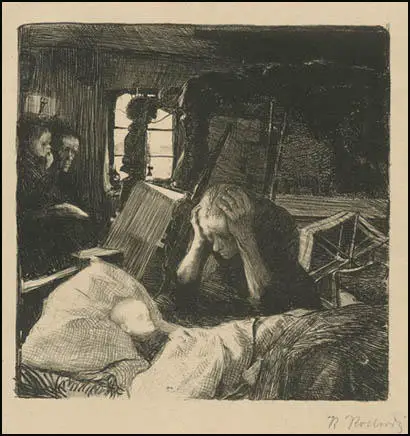
Adolf Menzel, who was considered the most important artist in the country, was so impressed with The Revolt of the Weavers that he proposed, as a member of the jury, to award the prestigious Gold Medal to Kollwitz. However, Wilhelm II, who disapproved of her socialist sympathies, vetoed the nomination. The following year, it was was exhibited at the Dresden Museum. The museum director proposed to the King of Saxony that Kollwitz be awarded the gold medal. The monarch agreed and in 1899 he conferred upon her the award. (175) She wrote in her journal: "from then on... I was counted among the foremost artists of the country". (176)
Käthe Kollwitz now began work on another series of etchings that dealt with the harsh conditions being endured by the working-class in Berlin. Completed in 1900, The Downtrodden, examines the lives of three victims of poverty. Kollwitz later recalled: "My real motive for choosing my subjects almost exclusively from the life of the workers was that only such subjects gave me a simple and unqualified way what I felt to be beautiful... The broad freedom of movement in the gestures of the common people had beauty. Middle-class people held no appeal for me at all. Bourgeois life as a whole seemed to me pedantic. The proletariat, on the other hand, had a grandness of manner, a breadth to their lives." (177)
Kollwitz was motivated by capturing the life of working-class people, "in their native rugged simplicity". She was not interested in those who concerned themselves with clothes, cosmetics, class, education, or convention. Kollwitz told Agnes Smedley: "I have never been able to see beauty in the uppere-class, educated person; he's superficial; he's not natural or true; he's not honest, and he's not a human being in every sense of the word." (178)
Kollwitz was especially interested in the lives of women. She often drew the women in her husband's waiting room: "The working-class woman shows me, through her appearance and being, much more than the ladies who are totally limited by conventional behaviour. The working-class woman shows me her hands, her feet and her hair. She lets me see the shape and form of her body through her clothes. She presents herself and the expression of her feelings openly, without disguises." (179)
Kollwitz agreed to teach part-time at the Berlin School for Women Artists. This included graphic arts and life drawing. However, she never felt comfortable doing this work as she was shy among strangers and accustomed to working in the unbroken solitude of a small, single room: "I had to show the class how to make an etching ground. The process was a book with seven seals to me and I perspired with embarrassment as I started to trot out my meager knowledge before the eager girls standing in a group around me." (180)
In 1904 Kollwitz visited Paris where she met Lily and Heinrich Braun, who were proposing a new socialist art journal, The New Society. While in the city she visited three of her fellow students at the Munich Women's Art School who had settled in France. One of the women was living in extreme poverty with her eleven-year-old son. Kollwitz agreed for Georg Gretor, to live with her in Berlin. (181)
Kollwitz also visited the studio of Auguste Rodin. She later recalled: "I shall never forget that visit. Rodin himself was taken up with other visitors. But he told us to go ahead and look at everything we could find in his atelier. In the center of a group of his big sculptures the tremendous Balzac was enthroned. He had small plaster sketches in glass cases. It was possible to see the full scope of his work, as well as to feel the personality of the old master." (182)
Max Klinger used his success to help younger artists. This included establishing the Villa Romana Prize. He purchased a villa in Florence, to which he invited outstandingly gifted artists (and their families) to live for cost free for up to a year. According to Martha Kearns the idea was for the artist to be given the opportunity to absorb "the rich influences of Medieval and Renaissance works of Florentine art." In 1906 Kollwitz was awarded the prize. She took her son Peter to the villa to help him recover from tuberculosis. (183)
Kollwitz spent her time studying the frescoes, sculpture, architecture and painting in the city. In her journal she explained that she found little to inspire her and during her stay in Italy she produced no work: "The enormous galleries are confusing, and they put you off because of the masses of inferior stuff in the pompous Italian vein. And so I have been trying the churches, with better luck. There are magnificent frescoes in the churches... And finally I again ventured into the Pitti and Uffizi Galleries. There are beautiful works here and there in them, but only here and there, it seems to me." (184)
While in Florence Kollwitz met her old friend, Emma Jeep, who had recently married Arthur Bonus. She also spent time with local artist, Constanza Harding. After Peter Kollwitz had returned to Berlin, the two women decided to hike through the tiny villages along the coastal route to Rome. A journey of around 150 miles. During the holiday the two women became very close again and on her arrival on 13th June, 1907, she described it as one of her life's great adventures. (185)
On her return to Germany she completed the series of drawings, The Peasant War. To produce the seven scenes she "combined aquatint and soft ground with the regular etching process". It is claimed by critics that Raped is one of the earliest pictures in Western art to depict a female victim of sexual violence sympathetically and from a woman's point of view. When the series was issued in 1908 it confirmed Kollwitz's stature as the most important graphic artists working in Europe. (186)
In 1909 Simplicissimus, a progressive journal published in Munich and run by a co-operative of artists that included Ludwig Thoma, Thomas Heine, Olaf Gulbransson, Rudolf Wilke and Edward Thony, commissioned her to produce a series of five drawings entitled Portraits of Misery. This was as a response to criticisms from the leaders of the Social Democratic Party (SDP). One newspaper reported: "The German worker simply does not look the way Simplicissimus portrays him. The worker, who strives courageously for the recognition of his personal worth, is insulted when he is portrayed as a drunkard or as a ragged street urchin living in an evil-smelling hovel." (187)
Käthe Kollwitz based her charcoal drawings on the working-class people who visited her husband's surgery for treatment. "I met the women who came to my husband for help and so, incidentally, came to me, I was gripped by the full force of the proletarian's fate. Unsolved problems such as prostitution and unemployment grieved and tormented me, and contributed to my feeling that I must keep on with my studies of the lower classes. And portraying them again and again opened a safety-valve for me; it made life bearable." When they were finished she wrote in her journal: "A happy day yesterday. Finished drawing the fifth and last plate for Simplicissimus... I am so glad that I can work well and easily now... As a result of so much working on studies I have at last reached the point where I have a certain background of technique which enables me to express what I want without a model." (188)
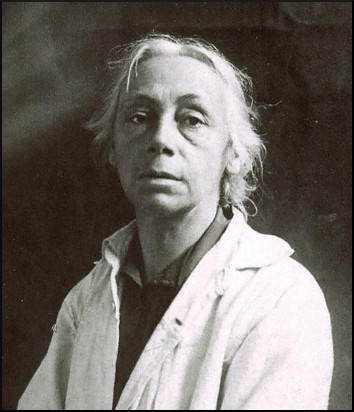
Hans Kollwitz pointed out that his mother found it difficult to express her emotions to her children: "Along with this reserve in talking about or showing love went a sisinclination to speak about feelings at all, or about any personal matters. She could speak about other people and what happened to them, about books, about problems, even about her own works; but actually she never spoke about herself. This was consistent with the attitude which had prevailed in her grandparents' and parents' households: that one's work could be considered important, but oneself never... To outsiders my mother gave the impression of being impregnable; only in her diaries can you see how she struggled with the antagonist within herself, and how essential that struggle was to her development." (189)
In 1910 Kollwitz completed Death, Woman, and Child. The author of Käthe Kollwitz (1976) has argued that Kollwitz identified with the mother figure in the picture: "The soft-ground etching is a masterpiece of line, space, and content. In its illustration of psychological tension through the drama of the body, Death and the Woman equals the artistry and emotional depth of Michelangelo's Rebellious Slave. A nude woman resembling the artist strains between a child who reaches for her and the skeleton of Death, which grasps her, pinning back her arms. The child touches her breasts, but cannot reach her tormented face; neither is the mother able to wrench free of Death to touch her child. The woman is bound, crucifix like, between Death and child, but in a dynamic pose: the line of her body curves powerfully from the right foot, through her taut thigh, to the near-circular arc of her breasts and her straining head, wrenched back in agony." (190)
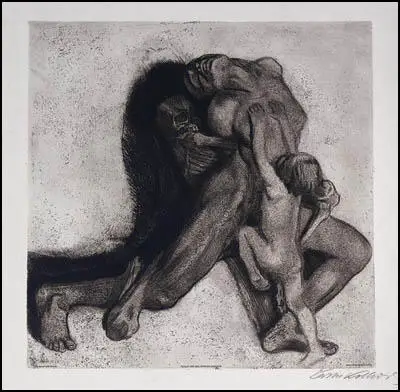
Kollwitz, now aged 43, wrote in her journal that she now spent most of her time in her studio working on her art: "I am gradually approaching the period in my life when work comes first. When both the boys went away for Easter, I hardly did anything but work. Worked, slept, ate and went for short walks. But above all I worked... No longer diverted by other emotions, I work the way a cow grazes." (191)
During this period she produced a poster on the housing crisis in Berlin. Underneath the drawing of a young woman holding a baby in her arms, were the words: "600,000 Berliners live in apartments in which five or more persons are living. Some hundred thousand children live in tenement housing without playgrounds." Kaiser Wilhelm II, who had already described Kollwitz's work as the "art of the gutter" ordered the posters to be removed on the grounds that it incited class hatred. (192)
The assassination of Archduke Franz Ferdinand on 28th June, 1914, triggered off the First World War. Käthe's two sons, Hans and Peter, immediately joined the German Army. She wrote in her journal: "Nothing is real but the frightfulness of this state, which we almost grow used to. In such times it seems so stupid that the boys must go to war. The whole thing is so ghastly and insane. Occasionally there comes that foolish thought: how can they possibly take part in such madness? And at once the cold shower: they must, must!" (193)
On 23rd October, 1914, Peter Kollwitz was killed at Dixmuide in Belgium on the Western Front. She wrote in her journal: "My Peter, I intend to try to be faithful.... What does that mean? To love my country in my own way as you loved it in your way. And to make this love work. To look at the young people and be faithful to them. Besides that I shall do my work, the same work, my child, which you were denied. I want to honor God in my work, too, which means I want to be honest, true, and sincere.... When I try to be like that, dear Peter, I ask you then to be around me, help me, show yourself to me. I know you are there, but I see you only vaguely, as if you were shrouded in mist. Stay with me.... my love is different from the one which cries and worries and yearns.... But I pray that I can feel you so close to me that I will be able to make your spirit." (194)
Kollwitz found it difficult to use her art to deal with her grief. She wrote in her journal: "Stagnation in my work... When it comes back (the grief) I feel it stripping me physically of all the strength I need for work. Make a drawing: the mother letting her dead son slide into her arms. I might make a hundred such drawings and yet I do not get any closer to him. I am seeking him. As if I had to find him in the work... For work, one must be hard and thrust outside one-self what one has lived through. As soon as I begin to do that, I again feel myself a mother who will not give up her sorrow. Sometimes it all becomes so terribly difficult." (195)
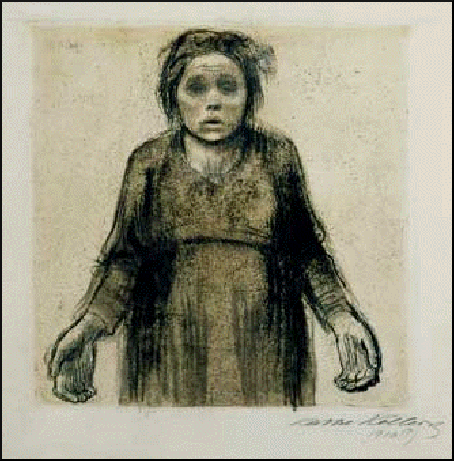
In 1916 she drew Anguish: The Widow. According to Martha Kearns: "A pregnant working-class woman, gaunt and harried, stands nearly full-length before us; her large-knuckled hands, cupped to hold and embrace, reach out limply in empty space. The woman is shocked and despondent from mourning; the woman is Kollwitz, who felt the widow's grief through the loss of her own son; the poor woman's desolation is her own." (196)
On 13th June, 1916, Käthe had been married to Karl Kollwitz for twenty-five years. In her journal she wrote: "I have never been without your love, and because of it we are now so firmly linked after twenty-five years. Karl, my dear, thank you. I have so rarely told you in words what you have been and are to me. Today I want to do so, this once. I thank you for all you have given me out of your love and kindness. The tree of our marriage has grown slowly, somewhat crookedly, often with difficulty. But it has not perished. The slender seedling has become a tree after all, and it is healthy at the core. It bore two lovely, supremely beautiful fruits." (197)
To commemorate Käthe's fiftieth birthday she was given a retrospective exhibition in Berlin. In May 1917 her sister, Lise Schmidt, wrote about the show in the socialist monthly, Sozialistische Monatshefte. Käthe wrote about the article in her journal: "She (Lise) makes a point which is for the most part ignored when people assert that my one subject is always the lot of the unfortunate. Sorrow isn't confined to social misery. All my work hides within it life itself, and it is with life that I contend through my work. At any rate I felt that Lise's conception is very close to mine." (198)
Käthe Kollwitz wanted to produce more positive art but found this impossible to do during the First World War. "How can one cherish joy when there is really nothing that gives joy? And yet the imperative is surely right. For joy is really equivalent to strength. It is possible to have joy within oneself and yet shoulder all the suffering. Or is it really impossible? If all the people who have been hurt by the war were to exclude joy from their lives, it would almost be as if they had died. Men without joy seem like corpses." (199)
Käthe Kollwitz also wrote about her feelings towards the war. She admitted that in 1914 she had not argued against her sons joining the German Army "because there was the conviction that Germany was in the right and had the duty to defend herself." However, by 1917 she had changed her view of the war: "The feeling that we were betrayed then, at the beginning. And perhaps Peter would still be living had it not been for this terrible betrayal. Peter and millions, many millions of other boys, all betrayed." (200)
On 7th November, 1918, Kurt Eisner, a member of the Independent Social Democratic Party (USPD) established a Socialist Republic in Bavaria. Several leading socialists arrived in the city to support the new regime. This included Erich Mühsam, Ernst Toller, Otto Neurath, Silvio Gesell and Ret Marut. Eisner also wrote to Gustav Landauer inviting him to Munich: "What I want from you is to advance the transformation of souls as a speaker." Landauer became a member of several councils established to both implement and protect the revolution. (201)
Kollwitz supported the revolutionaries but was opposed to the use of violence. Workers, soldiers and sailors responded to the news by going on strike and mutinying throughout Germany. Workers' Councils took control of factories and Soldiers' Councils undermined the authority of military officers. Käthe Kollwitz joined in this rebellion by helping the forming of a Workers' and Artist Council in Berlin. She also produced a charcoal drawing entitled, Revolution 1918 (1918). One critic pointed out the "charcoal drawing, transmits the passion, choas, and joy of the working classes as they scream, wave, and reach out to each other in the heat of revolution." (202)
The Social Democratic Party temporary government was less enthusiastic about the demands of the Workers' and Soldiers' Councils that included the socialization of key industries, the redistribution of land and a purge of the army, to be replaced by a people's militia. Instead the SPD government announced national elections. As a believer in democracy, Rosa Luxemburg assumed that her party, the Spartacus League, would contest these universal, democratic elections. However, other members were being influenced by the fact that Lenin had dispersed by force of arms a democratically elected Constituent Assembly in Russia. Luxemburg rejected this approach and wrote in the party newspaper: "The Spartacus League will never take over governmental power in any other way than through the clear, unambiguous will of the great majority of the proletarian masses in all Germany, never except by virtue of their conscious assent to the views, aims, and fighting methods of the Spartacus League." (203)
Luxemburg was aware that the Spartacus League only had 3,000 members and not in a position to start a successful revolution. The Spartacus League consisted chiefly of innumerable small and autonomous groups scattered all over the country. John Peter Nettl has argued that "organisationally Spartakus was slow to develop... In the most important cities it evolved an organised centre only in the course of December... and attempts to arrange caucus meetings of Spartakist sympathisers within the Berlin Workers' and Soldiers' Council did not produce satisfactory results." (204)
Pierre Broué suggests that the large meetings helped to convince Karl Liebknecht that a successful revolution was possible. "Liebknecht, an untiring agitator, spoke everywhere where revolutionary ideas could find an echo... These demonstrations, which the Spartakists had neither the force nor the desire to control, were often the occasion for violent, useless or even harmful incidents caused by the doubtful elements who became involved in them... Liebknecht could have the impression that he was master of the streets because of the crowds which acclaimed him, while without an authenic organisation he was not even the master of his own troops." (205)
On 1st January, 1919, there was a convention of the Spartacus League. Rosa Luxemburg, Paul Levi and Leo Jogiches all recognised that a "successful revolution depended on more than temporary support for certain slogans by a disorganised mass of workers and soldiers". (206) They were outvoted on this issue. As Bertram D. Wolfe has pointed out: "In vain did she (Luxemburg) try to convince them that to oppose both the Councils and the Constituent Assembly with their tiny forces was madness and a breaking of their democratic faith. They voted to try to take power in the streets, that is by armed uprising." (207)
On the 5th January, 1919, Friedrich Ebert called in the German Army and the Freikorps to bring an end to the rebellion. Groener later testified that his aim in reaching accommodation with Ebert was to "win a share of power in the new state for the army and the officer corps... to preserve the best and strongest elements of old Prussia". Ebert was motivated by his fear of the Spartacus League and was willing to use "the armed power of the far-right to impose the government's will upon recalcitrant workers, irrespective of the long-term effects of such a policy on the stability of parliamentary democracy". (208)
The soldiers who entered Berlin were armed with machine-guns and armoured cars and demonstrators were killed in their hundreds. Artillery was used to blow the front off the police headquarters before Eichhorn's men abandoned resistance. "Little quarter was given to its defenders, who were shot down where they were found. Only a few managed to escape across the roofs." (209)
By 13th January, 1919 the rebellion had been crushed and most of its leaders were arrested. This included Rosa Luxemburg and Karl Liebknecht, who refused to flee the city, and were captured on 16th January and taken to the Freikorps headquarters. "After questioning, Liebknecht was taken from the building, knocked half conscious with a rifle butt and then driven to the Tiergarten where he was killed. Rosa was taken out shortly afterwards, her skull smashed in and then she too was driven off, shot through the head and thrown into the canal." (210)
On the morning of the funeral Käthe Kollwitz visited the Liebknecht home to offer sympathy to the family. At their request, she made drawings of him in his coffin. She noted that there were red flowers around his forehead, where he had been shot. She wrote in her journal: "I am trying the Liebknecht drawing as a lithograph... Lithography now seems to be the only technique I can still manage. It's hardly a technique at all, its so simple. In it only the essentials count." However, she changed her mind and it became a woodcut. (211)
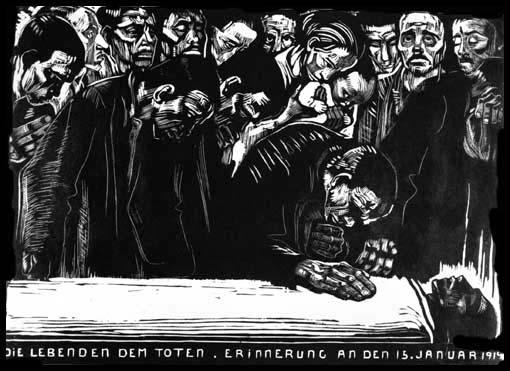
The Karl Liebknecht woodcut was attacked by the German Communist Party (KPD) because it had not been produced by a member of the party. Kollwitz wrote in her journal: "As an artist who moreover is a woman cannot be expected to unravel these crazily complicated relationships. As an artist I have the right to extract the emotional content out of everything, to let things work upon me and then give them outward form. And so I also have the right to portray the working class's farewell to Liebknecht, and even dedicate it to the workers, without following Liebknecht politically." (212)
In 1919 Kollwitz became the first woman to be elected to full professorship at the Prussian Academy of Arts. (213) As part of the position she was given a large, fully equipped studio with side rooms. In her new studio she began work on a series of lithographs that dealt with the impact of the First World War on women. Kollwitz later recorded: "I first began the war series as etchings. Came to nothing... I can no longer etch; I'm through with that for good. and in lithography there are the inadequacies of the transfer paper. Nowadays lithographic stones can only be got to the studio by begging and pleading, and cost a lot of money, and even on stones I don't manage to make it come out right. Why can't I do it any more? The prerequisites for artistic works have been there - for example in the war series. First of all the strong feeling - these things come from the heart - and secondly they rest on the basis of my previous works, that is, upon a fairly good foundation of technique." (214)
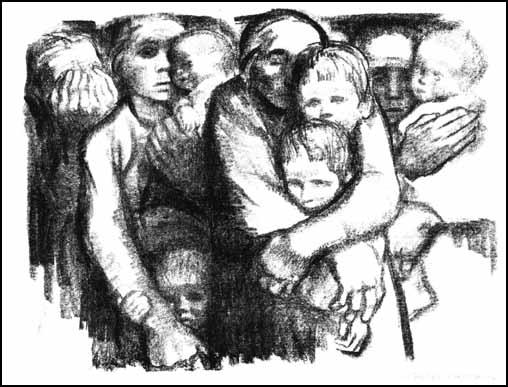
Kollwitz's failure to support the Spartacus League Uprising made her realise that she was not as revolutionary as she thought: "I have been through a revolution, and I am convinced that I am no revolutionist. My childhood dream of dying on the barricades will hardly be fulfilled, because I should hardly mount a barricade now that I know what they are like in reality. And so I know now what an illusion I lived in for so many years. I thought I was a revolutionary and was only an evolutionary. Yes, sometimes I do not know whether I am a socialist at all, whether I am not rather a democrat instead." (215)
In 1920 she produced a self-portrait, Woman Lost in Thought. It reflected her mood at the time. She wrote: "I am disillusioned with all the hate that is in the world. I long for Socialism which allows people to live - the world has seen enough murder, lies, and corruption." This was followed with Death with Women in Lap, in which a tired woman is cradled in the lap and arms of Death. She wrote in her journal: "I am no longer expanding outward; I am contracting into myself. I mean that I am noticeably growing old." (216)
Later that year Kollwitz joined Albert Einstein, George Grosz, Maxim Gorki, George Bernard Shaw, Henri Barbusse, Willi Münzenberg, Clara Zetkin, Upton Sinclair and Ernst Toller to form the International Workers Aid (IAH). She produced several posters for the organisation including Help Russia and Vienna is Dying! Save her Children!. (217) During this period she wrote: "At such moments, when I know I am working with an international society opposed to war, I am filled with a warm sense of contentment. I know, of course, that I do not schieve pure art... But it is still art." (218)
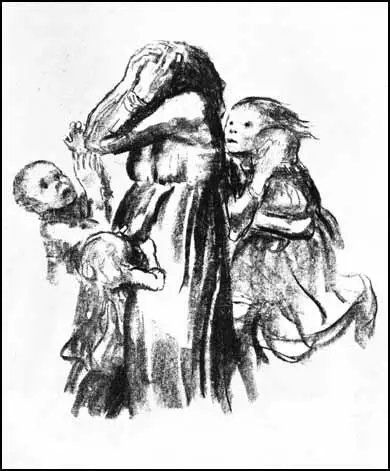
Käthe Kollwitz finished her series on the First World War in 1923. She told her friend, Erna Kruger: "Everything has gone so well with me concerning my work... If there is a section I have not re-worked, I do not know about it. A work of many years is finally coming to a close. They include an analysis of the piece of life that the years of life 1914-1918 encompass. These four years were very difficult to grasp... I have received a commission from the International Trade Union Congress to make a poster against war. That is a task that makes me happy. Some may say a thousand times, that this is not pure art, which has a purpose. But as long as I can work, I want to be effective with my art." (219)
Kollwitz was also an active member of the Women's International League for Peace and Freedom (WILPF). The organisation was established in 1915 and after the war campaigned for peace, disarmament and international co-operation. Other members included Jane Addams, Mary Sheepshanks, Mary McDowell, Florence Kelley, Alice Hamilton, Anna Howard Shaw, Belle La Follette, Fanny Garrison Villard, Emily Balch, Jeanette Rankin, Lillian Wald, Edith Abbott, Grace Abbott, Crystal Eastman, Carrie Chapman Catt, Sophonisba Breckinridge, Aletta Jacobs, Emmeline Pethick-Lawrence, Emily Hobhouse, Chrystal Macmillan and Rosika Schwimmer.
Kollwitz produced lithographs of war-stricken mothers and children for the organisation. that were distributed as postcards. She also produced a poster, The Survivors, which showed those uprooted by war, for the International Trade Congress (ITC). (220) She had wanted to draw a feminist-orientated picture of "mothers pressed together like animals, protecting their brood in a cluster of black", but the ITC preferred a depiction of survivors. The final drawing showed those uprooted by the war - "the parents, widows, blind people, and all their children with their fearful, questioning, helpless eyes and pale faces." (221)
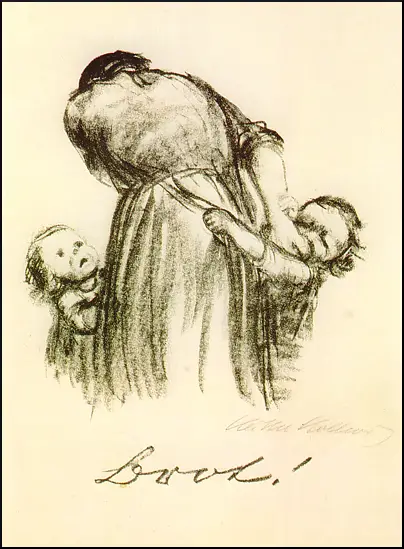
In 1924 she produced another anti-war poster, Never Again War. The author of Käthe Kollwitz (1976) has pointed out: "In this work her anger over the war dominates her sorrow. A zealous youth summons others to pacifism: his black eyebrows arch, his hair sweeps back dramatically as he stretches his right arm, first two fingers pointing in a visual exclamation point to the clarion call Never Again War!, writ large on either side of his arm." (222)
In September 1925 Kollwitz was interviewed by the journalist, Agnes Smedley, who argued: "She (Kollwitz) is now fifty-eight years of age, and remains unimpressed by attentions, medals, books, or professorships. Her ceaseless physical activity would lead one to believe she is no more than forty. Her life is as simple as that of an ordinary working woman, and she still lives in the workers' section of North Berlin. Her gaze is direct and her voice startlingly strong, and she sees far beyond those who bring her superficial, external tributes or who try to use her for their own propaganda purposes. She is a silent person, but when she speaks it is with great directness, without trimmings to suit the prejudices of her hearers. Many people, before meeting her, expect to see a bitter woman. But they see, instead, a kind - very kind - woman to whom love - strong, love, however - is the rule of life." (223)
In 1925 Käthe Kollwitz completed a series of woodcuts entitled The Proletariat. As with her other work, the woodcuts are made from the point of view of a working-class woman having to deal with living in poverty. The most disturbing image in the series is Hunger "shows terrified women and children crawling through thick darkness, as Death, represented as a skull, brandishes a lasso over their heads. The Children Die, the final frame, is the sharpest and most emphatic of the series. Stupefield with grief, a mother holds a child's coffin in her work-muscled hands. Thin, long-knived strokes abstract her features, giving her face the impressionable quality of rock." (224)
On the death of Peter Kollwitz during the First World War, Käthe attempted to create a memorial to her son. Every attempt she made ended in failure. Eventually she decided to make two sculptures, The Mother and The Father. She was given permission to place them in the cemetery where he was buried. In June, 1926, Käthe and Karl Kollwitz visited the cemetery in Dixmuide in Belgium, to decide where they were to be placed. She later recalled: "The cemetery is close to the highway.... The entrance is nothing but an opening in the hedge that surrounds the entire field. It was blocked by barbed wire which a friendly young man bent aside for us; then he left us alone. What an impression: cross upon cross.... on most of the graves there were low, yellow wooden crosses. A small metal plaque in the center gives the name and number. So we found our grave.... We cut three tiny roses from a flowering wild briar and placed them on the ground beside the cross. All that is left of him lies there in a row-grave. None of the mounds are separated; there are only the same little crosses placed quite close together.... and almost everywhere is the naked, yellow soil.... at least half the graves bear the inscription unknown German... We considered where my figures might be placed... What we both thought best was to have the figures just across from the entrance, along the hedge.... Then the kneeling figures would have the whole cemetery before them." (225)
In 1927 Kollwitz was invited to visit the Soviet Union. Although she was a supporter of the Social Democratic Party (SDP) and opposed communist revolution, she did accept that the country had introduced some important progressive reforms. Kollwitz wrote in Arbeiters International Zeitung: "This is not the place for us to discuss why I am not a Communist. But it is the place for me to state that, as far as I am concerned, what has happened in Russia during the last ten years seems to be an event which both in stature and significance is comparable only with that of the great French Revolution. An old world, sapped by four years of war and undermined by the work of revolutionaries, fell to pieces in November 1917. The broad outline of a new world was hammered together. In an essay written during the early days of the Soviet Republic, Maksim Gorki speaks of flying with one's soles turned upwards. I believe that I too can sense such flying in the gale inside Russia. For this flying of theirs, for the fervour of their beliefs, I have often envied the Communists." (226)
The memorial to her son was not finished until 1931. It went on display at the Prussian Academy of Arts until being moved to Belgium: "For years I worked on them in utter silence, showed them to no one, scarcely even to Karl and Hans; and now I am opening the doors wide so that as many people as possible may see them. A big step which troubles and excites me; but it has also made me very happy because of the unanimous acclaim of my fellow artists." Otto Nagel described the memorial as the "artistic sensation of the day". (227)
In the General Election that took place in September 1930, the Nazi Party increased its number of representatives in parliament from 14 to 107. Adolf Hitler was now the leader of the second largest party in Germany. The Social Democratic Party was the largest party in the Reichstag, but it did not have a majority over all the other parties, and the SPD leader, Hermann Muller, had to rely on the support of others to rule Germany. Harold Harmsworth, 1st Lord Rothermere, wrote in The Daily Mail after the general election result: "What are the sources of strength of a party which at the general election two years ago could win only 12 seats, but now, with 107, has become the second strongest in the Reichstag, and whose national poll has increased in the same time from 809,000 to 6,400,000? Striking as these figures are, they stand for something far greater than political success. They represent the rebirth of Germany as a nation." (228)
Kollwitz watched these political developments with deep misgivings. The Nazi's use of brute force to suppress a workers' rally angered her; it also alerted her to the imminent political danger. She reacted against the political repression by drawing Demonstration, a scene of a workers' rally in which a group of staunch men, singing, protest civil and economic policies. (229)
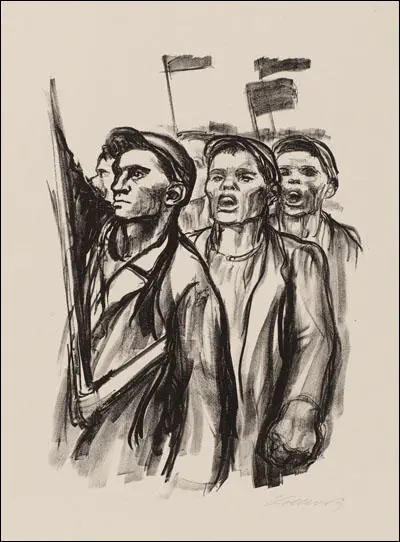
In May 1932 General Hans von Seeckt joined up with Alfred Hugenberg, Hjalmar Schacht, and several industrialists, to call for the uniting of the parties of the right. They demanding the resignation of Heinrich Brüning. Germany's president, Paul von Hindenburg, agreed and forced him to leave office and on 1st June he was replaced as chancellor by Franz von Papen. The new chancellor was also a member of the Catholic Centre Party and, being more sympathetic to the Nazis, he removed the ban on the SA. The next few weeks saw open warfare on the streets between the Nazis and the Communists during which 86 people were killed. (230)
On 4th January, 1933, Adolf Hitler had a meeting with Franz von Papen and decided to work together for a government. It was decided that Hitler would be Chancellor and Von Papen's associates would hold important ministries. "They also agreed to eliminate Social Democrats, Communists, and Jews from political life. Hitler promised to renounce the socialist part of the program, while Von Papen pledged that he would obtain further subsidies from the industrialists for Hitler's use... On 30th January, 1933, with great reluctance, Von Hindenburg named Hitler as Chancellor." (231)
On 27th February, 1933, the Reichstag parliamentary building caught fire. It was reported at ten o'clock when a Berlin resident telephoned the police and said: "The dome of the Reichstag building is burning in brilliant flames." The Berlin Fire Department arrived minutes later and although the main structure was fireproof, the wood-paneled halls and rooms were already burning. (232)
Hermann Göring, who had been at work in the nearby Prussian Ministry of the Interior, was quickly on the scene. Adolf Hitler and Joseph Goebbels arrived soon after. So also did Rudolf Diels: "Shortly after my arrival in the burning Reichstag, the National Socialist elite had arrived. On a balcony jutting out of the chamber, Hitler and his trusty followers were assembled." Göring told him: "This is the beginning of the Communist Revolt, they will start their attack now! Not a moment must be lost. There will be no mercy now. Anyone who stands in our way will be cut down. The German people will not tolerate leniency. Every communist official will be shot where he is found. Everybody in league with the Communists must be arrested. There will also no longer be leniency for social democrats." (233)
Hitler gave orders that all leaders of the German Communist Party (KPD) should "be hanged that very night." Paul von Hindenburg vetoed this decision but did agree that Hitler should take "dictatorial powers". Orders were given for all KPD members of the Reichstag to be arrested. This included Ernst Torgler, the chairman of the KPD. Göring commented that "the record of Communist crimes was already so long and their offence so atrocious that I was in any case resolved to use all the powers at my disposal in order ruthlessly to wipe out this plague". (234)
Käthe Kollwitz helped organise a public manifesto calling for unity between the Social Democrat Party and the German Communist Party in order to combat to rise of fascism. Hitler responded by demanding that Kollwitz and Heinrich Mann, another organiser of the manifesto, should resign from the Prussian Academy of Arts. Kollwitz wrote to her friend, Emma Jeep: "Has the Academy affair reached your ears yet? That Heinrich Mann and I, because we signed the manifesto calling for unity of the parties of the left, must leave the Academy. It was all terribly unpleasant for the Academy directors. For fourteen years... I have worked together peacefully with these people. Now the Academy directors have had to ask me to resign. Otherwise the Nazis had threatened to break up the Academy. Naturally I complied. So did Heinrich Mann. Municipal Architect Wagner also resigned, in sympathy." (235)
After losing her Academy studio, Kollwitz was unable to continue with her sculpture. Now aged 67, she decided to do a series of lithographs on her own impending death: "I thought that now that I am really old I might be able to handle this theme in a way that would plumb depths... But that is not the case... At the very point when death becomes visible behind everything, it disrupts the imaginative process... I start off indecisively, soon tire, need frequent pauses and must turn for counsel to my own earlier works." (236)
Käthe Kollwitz continued to criticise Adolf Hitler and his Nazi Government. Along with her friend, Otto Nagel, she gave an interview with Izvestia. In July, 1936, she was arrested by the Gestapo. They wanted to know the names of other German artists who shared her anti-Nazi beliefs. They warned her that if she did not cooperate she would be sent to a concentration camp. She remained silent and because of her age, she was released. (237)
On 27th November, 1936, Joseph Goebbels issued the following decree: "On the express authority of the Führer, I hereby empower the President of the Reich Chamber of Visual Arts, Professor Ziegler of Munich, to select and secure for an exhibition works of German degenerate art since 1910, both painting and sculpture, which are now in collections owned by the German Reich, by provinces, and by municipalities. You are requested to give Professor Ziegler your full support during his examination and selection of these works." It is estimated that 31 of Kollwitz's works were confiscated. (238)
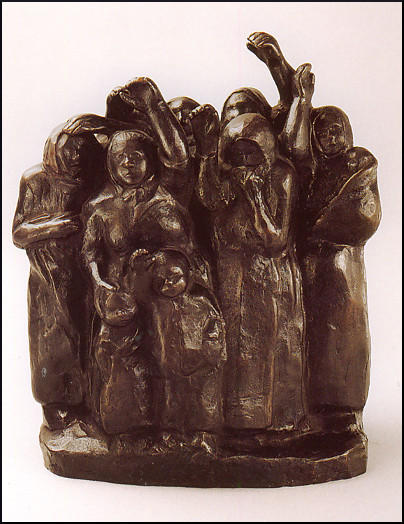
In 1938 she finished the sculpture, Tower of Mothers. When this was shown at a local exhibition, it was seized by the Nazi government and described as being an example of "degenerate art". She wrote in her journal: "There is this curious silence surrounding the expulsion of my work from the Academy show.... Scarcely anyone had anything to say to me about it. I thought people would come, or at least write - but no. Such a silence around us." (239)
The Nazi government also banned Karl Kollwitz from working as a doctor in Berlin. Eric Cohn, a wealthy art collector in the United States, purchased some of her sculptures that enabled the couple to buy enough food to survive. Cohen also offered to help Kollwitz to take refuge in the United States, but she refused as she did not want to be separated from her family. Karl, who had an unsuccessful eye operation for cataracts, became increasing weak and by the outbreak of the Second World War he was completely bedridden. Käthe, who had to use a cane for walking, became his constant nurse and companion. He died on 19th July, 1940. (240)
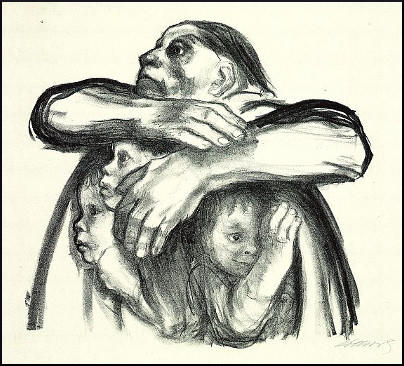
In January, 1942, Kollwitz, aged 74, produced her last lithographic, Seed Crops should not be Milled. She wrote in her journal, "I have finished my lithograph... This time the seed for the planting - sixteen-year-old boys - are all around the mother, looking out from under her coat and wanting to break loose. But the old mother who is holding them together says, No! You stay here! For the time being you may play rough-and-tumble with one another. But when you are grown up you must get ready for life, not for war again." (241)
Käthe Kollwitz, whose grandson, Peter, was named after her son killed in the First World War, joined the German Army. He was killed during the advance on Stalingrad in October, 1942. His father, Hans Kollwitz, recalled: "Even then she bore herself proudly, did not grieve openly, scarcely wept; she tried to give us strength to bear it. But the blow had been deep and damaging." (242)
In 1943 Kollwitz produced her last self-portrait. Her biographer, Martha Kearns, has argued: "It is the last of eighty-four self-portraits, possibly the longest chronology of self-portraits by a woman in Western art, certainly a stunning psychological charting of a woman's life." (243)
The terror-bombing of Berlin meant that in the summer of 1943, Kollwitz was forced to seek refuge in the home of a friend in Nordhausen. She was a prolific letter writer and in one letter to Georg Gretor, her adopted son, she wrote: "Oh, Georg, how good it all was... the fullness and richness of our lives overwhelms me again and again with feelings of gratitude. Let us tell you once more how we all have loved you." (244)
On 23rd November, 1943, her apartment on 25 Weissenburger Strasse was destroyed by bombs and she lost family photographs, letters and mementos of her husband, sons and grandsons. She wrote: "It was my home for more than fifty years. Five persons whom I have loved so dearly have gone away from those rooms forever. Memories filled all the rooms... Only an idea remains, and that is fixed in the heart." (245)
A week later her son's home was also destroyed during a bombing raid. Kollwitz wrote in her journal: "every war already carries within it the war which will answer it. Every war is answered by a new war, until everything, everything is smashed... That is why I am so wholeheartedly for a radical end to this madness, and why my only hope is in a world socialism... Pacifism simply is not a matter of calm looking on; it is work, hard work." (246)
Käthe Kollwitz died, aged seventy-eight, at Moritzburg on 22nd April, 1945. Her biographer, Martha Kearns, commented: "She died without worldly possessions, but rich in her own person." In her time she had developed the strength "to take life as it is... to do one's work powerfully... not to deny oneself, the personality one happens to be, but to embody it." (247)
